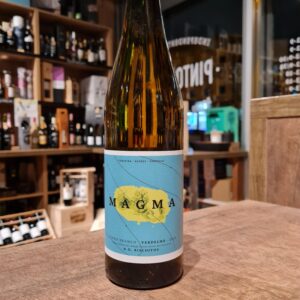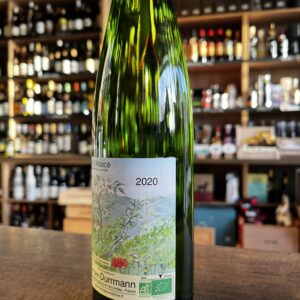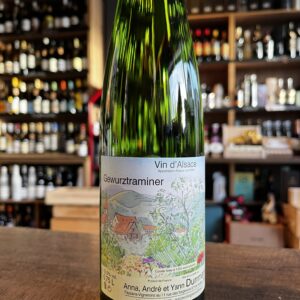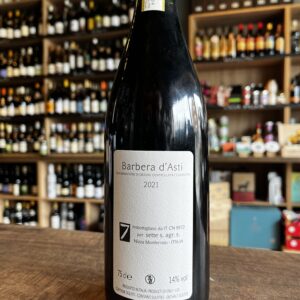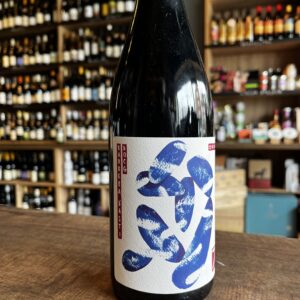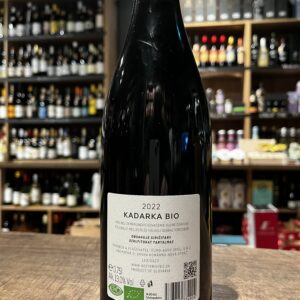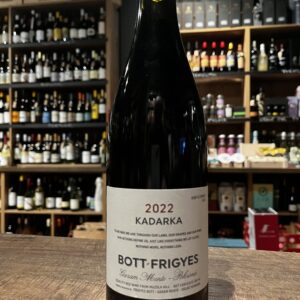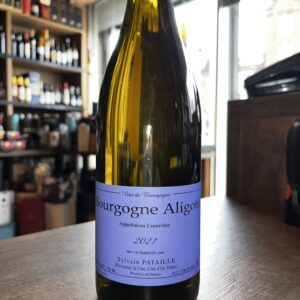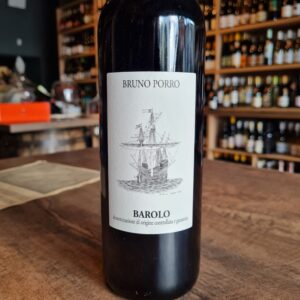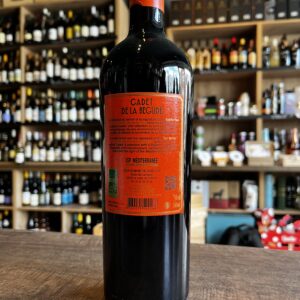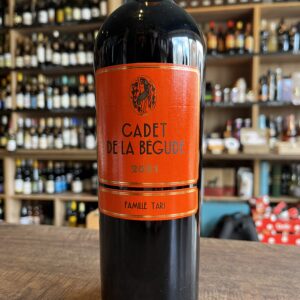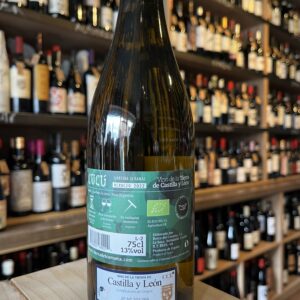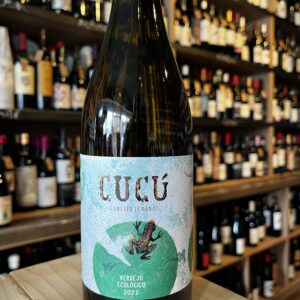Organic wine
A wine can be defined “organic” when it is made with 100% organic grapes grown without the use of synthetic chemicals in the vineyards, while the vinification process must take place with a limited use of certified sulphites and oenological organic products.
-
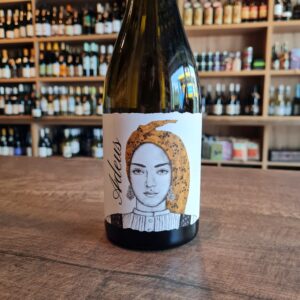 Adeus is the same in Galician as it is Portuguese and means ''Goodbye''. It is also the title of a Galician poem done by one of the most famous poets of Galicia, Rosalia de Castro. One worth that stays in between the love for her land and a homage to a woman that means so much for the history of Galicia. The Ribeiro is 45 km inland from the Atlantic Ocean and is situated in the middle of Valleys that protects it from the Atlantic winds. With 3 Rivers crossing has excellent conditions to produce wine. An excellent pair to grilled octopus with white asparagus garnish, monkfish fillet with stewed spinach and shrimps in garlic sauce
Adeus is the same in Galician as it is Portuguese and means ''Goodbye''. It is also the title of a Galician poem done by one of the most famous poets of Galicia, Rosalia de Castro. One worth that stays in between the love for her land and a homage to a woman that means so much for the history of Galicia. The Ribeiro is 45 km inland from the Atlantic Ocean and is situated in the middle of Valleys that protects it from the Atlantic winds. With 3 Rivers crossing has excellent conditions to produce wine. An excellent pair to grilled octopus with white asparagus garnish, monkfish fillet with stewed spinach and shrimps in garlic sauce -
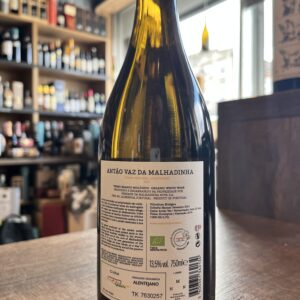
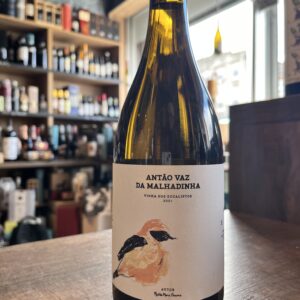 Herdade da Malhadinha Nova is the representation of an ambitious and innovative project of the Soares family, who have transformed a piece of Alentejo land, into one of the most beautiful and charismatic estates in the Alentejo. Located in Albernoa and currently possessing 80 hectares of vineyards, it is here that wines full of personality are created, whose labels are based on the children's drawings of their offspring. In addition to the focus on vines and wine, the estate is also farmed for olive groves and olive oil production, as well as rural and wine tourism activities.
Herdade da Malhadinha Nova is the representation of an ambitious and innovative project of the Soares family, who have transformed a piece of Alentejo land, into one of the most beautiful and charismatic estates in the Alentejo. Located in Albernoa and currently possessing 80 hectares of vineyards, it is here that wines full of personality are created, whose labels are based on the children's drawings of their offspring. In addition to the focus on vines and wine, the estate is also farmed for olive groves and olive oil production, as well as rural and wine tourism activities. -
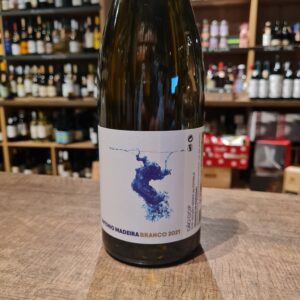
 António Madeira is a Frenchman with Portuguese roots who considers that the heart of Dão, one of Portugal’s most interesting wine regions, is in the Serra do Estrela, which is where he can trace his Portuguese roots back to. Madeira has been researching the area since 2010, and he has managed to rescue interesting vineyards with abandoned old vines growing an impressive number of native varieties. This is winemaking that dates back a long time, where the plots have special granite soils, a good altitude and sun exposure and they are cultivated with great care for the environment. All of these factors result in authentic wines, with an honest personality. An excellent return to origins.
António Madeira is a Frenchman with Portuguese roots who considers that the heart of Dão, one of Portugal’s most interesting wine regions, is in the Serra do Estrela, which is where he can trace his Portuguese roots back to. Madeira has been researching the area since 2010, and he has managed to rescue interesting vineyards with abandoned old vines growing an impressive number of native varieties. This is winemaking that dates back a long time, where the plots have special granite soils, a good altitude and sun exposure and they are cultivated with great care for the environment. All of these factors result in authentic wines, with an honest personality. An excellent return to origins. -
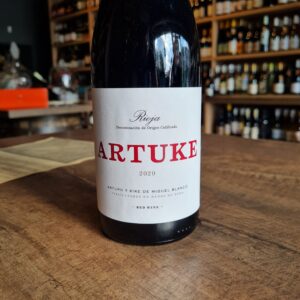 Made in a Beaujolais style, with the carbonic maceration method. This juicy ''Joven'' fresh fruited style of Rioja has zero oak influence as it ages in concrete tanks for 6 months. Farmed without any synthetic fertilizers or pesticides. Arturo Blanco was once asked what the philosophy at Bodegas Artuke was and he simply replied 'we are farmers'. The approach here is 100% focused on interpreting the family's 32 plots which are split between the villages of Baños de Ebro and Ábalos in Rioja Alavesa. Biodynamic techniques are employed in the vineyards and Arturo and Kike are also busy recovering old, ignored plots of ancient vines. Vinification is aimed at expressing the characteristics of the vineyard and quality of fruit above all else. The restrained use of oak and inclination towards different types/sizes of barrel, plus an unwillingness to adhere to the subscribed regimes for classification means that Artuke are precluded from using Crianza, Reserva and Gran Reserva designations on their wines. This mouth-watering red wine takes a relatively deep chill which makes it a versatile pairing with all types of food: tuna, pretty much anything made with zucchini, fried chicken, gooey cheese sandwiches, pizza, etc…
Made in a Beaujolais style, with the carbonic maceration method. This juicy ''Joven'' fresh fruited style of Rioja has zero oak influence as it ages in concrete tanks for 6 months. Farmed without any synthetic fertilizers or pesticides. Arturo Blanco was once asked what the philosophy at Bodegas Artuke was and he simply replied 'we are farmers'. The approach here is 100% focused on interpreting the family's 32 plots which are split between the villages of Baños de Ebro and Ábalos in Rioja Alavesa. Biodynamic techniques are employed in the vineyards and Arturo and Kike are also busy recovering old, ignored plots of ancient vines. Vinification is aimed at expressing the characteristics of the vineyard and quality of fruit above all else. The restrained use of oak and inclination towards different types/sizes of barrel, plus an unwillingness to adhere to the subscribed regimes for classification means that Artuke are precluded from using Crianza, Reserva and Gran Reserva designations on their wines. This mouth-watering red wine takes a relatively deep chill which makes it a versatile pairing with all types of food: tuna, pretty much anything made with zucchini, fried chicken, gooey cheese sandwiches, pizza, etc… -
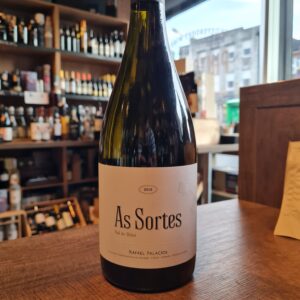 Rafael Palacios is the son of D. José Palacios Remondo (founder of Bodegas Palacios Remondo) and the brother of Alvaro Palacios(Priorat) but ultimately a passionate producer of white wine. After producing his first white at the family-run winery, called Plácet, he decided to set up his own winery in Galicia, in the Valle del Bibei, under the Valdeorras denomination. Established in 2004, Rafael Palacios has rapidly become one of Spain’s greatest producers of white wine. His focus is on the local variety Godello, grown in a small estate on very old vines that are up to 90 years old from the areas steep-sided, terraced vineyards and have been cultivated with respect of the land, without using any type of herbicide or pesticide. Rafael Palacios is refining his work year after year, reaching the magic of the greatest wines. A top wine, and one to keep. Grub pairing suggestions are mild Asian dishes, Moroccan specialities, fish ragout with saffron sauce Risotto ai frutti di mar
Rafael Palacios is the son of D. José Palacios Remondo (founder of Bodegas Palacios Remondo) and the brother of Alvaro Palacios(Priorat) but ultimately a passionate producer of white wine. After producing his first white at the family-run winery, called Plácet, he decided to set up his own winery in Galicia, in the Valle del Bibei, under the Valdeorras denomination. Established in 2004, Rafael Palacios has rapidly become one of Spain’s greatest producers of white wine. His focus is on the local variety Godello, grown in a small estate on very old vines that are up to 90 years old from the areas steep-sided, terraced vineyards and have been cultivated with respect of the land, without using any type of herbicide or pesticide. Rafael Palacios is refining his work year after year, reaching the magic of the greatest wines. A top wine, and one to keep. Grub pairing suggestions are mild Asian dishes, Moroccan specialities, fish ragout with saffron sauce Risotto ai frutti di mar -
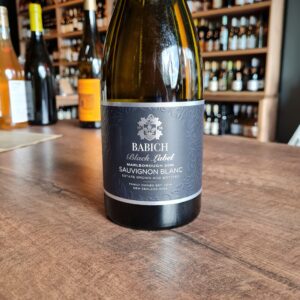 The Babich family hails from Croatia and first bought land in New Zealand in 1916. The winery is now in its third generation. Fruit for this wine comes from a variety of its estate-owned vineyards which are sustainable or organic. Most of the juice for this wine is fermented in stainless steel with a small percentage in old oak. Crafted with food in mind-weighty, ripe, tropical fruit, flavoured style, rich and rounded. Pair it with veal, seafood (oysters) or a chicken dish.
The Babich family hails from Croatia and first bought land in New Zealand in 1916. The winery is now in its third generation. Fruit for this wine comes from a variety of its estate-owned vineyards which are sustainable or organic. Most of the juice for this wine is fermented in stainless steel with a small percentage in old oak. Crafted with food in mind-weighty, ripe, tropical fruit, flavoured style, rich and rounded. Pair it with veal, seafood (oysters) or a chicken dish. -
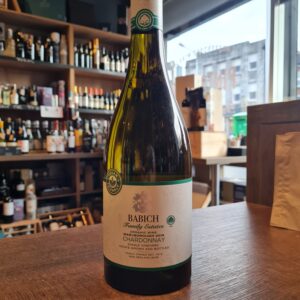 Family Estates Organic Marlborough Chardonnay; a complex style of Chardonnay grown in our Headwaters vineyard in Marlborough. The cooler climate and alluvial soils of Marlborough deliver flavour and varietal complexity that is reflective of the region and our winemaker’s commitment to sustainably crafting the most drinkable New Zealand wines in the world. This organic Chardonnay wine would go well with poultry or fish or vegetable medley.
Family Estates Organic Marlborough Chardonnay; a complex style of Chardonnay grown in our Headwaters vineyard in Marlborough. The cooler climate and alluvial soils of Marlborough deliver flavour and varietal complexity that is reflective of the region and our winemaker’s commitment to sustainably crafting the most drinkable New Zealand wines in the world. This organic Chardonnay wine would go well with poultry or fish or vegetable medley. -
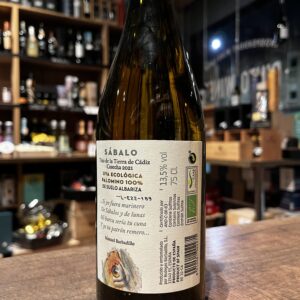
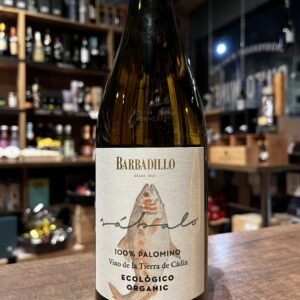 Sábalo is produced from 100% ecological Palomino Fino grapes and it is a spectacular wine, the true fruit of our many years of expertise. The grapes used to produce this wine are harvested in the white albariza soils of Sanlúcar, and as such the sea, the marshlands and the Guadalquivir River all form part of what is essentially Sábalo’s DNA.
Sábalo is produced from 100% ecological Palomino Fino grapes and it is a spectacular wine, the true fruit of our many years of expertise. The grapes used to produce this wine are harvested in the white albariza soils of Sanlúcar, and as such the sea, the marshlands and the Guadalquivir River all form part of what is essentially Sábalo’s DNA. -
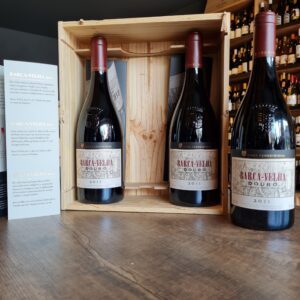 Casa Ferreirinha, was acquired by Sogrape Vinhos in 1987, its wines are synonymous with time and art. This has happened since its foundation, in the 18th century, by the hand of Bernardo Ferreira, who saw the formula refined by his descendants, especially by his granddaughter Dona Antónia Adelaide Ferreira, who affectionately became known as "Ferreirinha" or "Ferreirinha-da-Régua" for the people of that land. Through the hands of Dona Antónia, who twice widowed herself at the head of a large company, Ferreira consolidated itself admirably. Her entrepreneurial spirit taught her to foresee, decide, create, teach and love, making her a figure of great projection and charisma. Barca Velha is the result of the passion of Fernando Nicolau de Almeida (Casa Ferreirinha Head Winemaker in 1952), who envisioned a high quality Douro Red Wines made with the aging potential of Vintage Ports. The first harvest was 1952. Barca Velha is only released in exceptional years, current head winemaker Luis Sottomayor began his career at this house as an apprentice learning directly from Fernando Nicolau D'Almeida. ''2011 was an extraordinary year-one of the best ever in Douro-Intense and exceptional quality. When this wine was born, we soon realized that it would be destined for Barca-Velha”. But even so, it was necessary to pass the great test of time with distinction. In the barrels, first, and then in the bottle, it was followed and evaluated over nine years, until the final decision was made.
Casa Ferreirinha, was acquired by Sogrape Vinhos in 1987, its wines are synonymous with time and art. This has happened since its foundation, in the 18th century, by the hand of Bernardo Ferreira, who saw the formula refined by his descendants, especially by his granddaughter Dona Antónia Adelaide Ferreira, who affectionately became known as "Ferreirinha" or "Ferreirinha-da-Régua" for the people of that land. Through the hands of Dona Antónia, who twice widowed herself at the head of a large company, Ferreira consolidated itself admirably. Her entrepreneurial spirit taught her to foresee, decide, create, teach and love, making her a figure of great projection and charisma. Barca Velha is the result of the passion of Fernando Nicolau de Almeida (Casa Ferreirinha Head Winemaker in 1952), who envisioned a high quality Douro Red Wines made with the aging potential of Vintage Ports. The first harvest was 1952. Barca Velha is only released in exceptional years, current head winemaker Luis Sottomayor began his career at this house as an apprentice learning directly from Fernando Nicolau D'Almeida. ''2011 was an extraordinary year-one of the best ever in Douro-Intense and exceptional quality. When this wine was born, we soon realized that it would be destined for Barca-Velha”. But even so, it was necessary to pass the great test of time with distinction. In the barrels, first, and then in the bottle, it was followed and evaluated over nine years, until the final decision was made. -
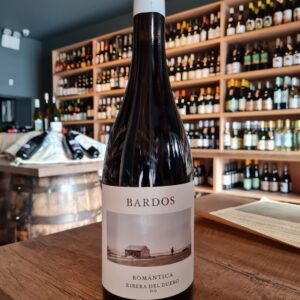 Bardos Romantica is a red wine from Ribera del Duero, produced by Bodegas Bardos, belonging to the Vintae Group, which are known to produce wines in twelve different Spanish regions, such as the Hacienda López from Haro. Made from 100% Tinta del País (Tempranillo). The grapes come from a rigorous selection of low yielding old vines located in the highlands of the central plateau in Onesimus Quintanilla (Valladolid). The grapes, once collected, are transported to the winery in boxes of 15 kilos and small trailers. Here a selection of bunches is made on tables. Subsequent fermentation and maceration is carried out in vats at a temperature of 28ªC for 3 or 4 weeks. Once fermented and macerated, Bardos Romantica undergoes a malolactic fermentation in French oak barrels, with a weekly beating and strict control of each barrel. Finally, Bardos Romantica is aged for 14 months in barrels of one and two years in French oak, located in underground cellars where the temperature is maintained throughout the year at around 14ºC. Bardos Romantica is a soft and original wine. After all the technicalities all I can say is a great wine, enjoy it, share it!
Bardos Romantica is a red wine from Ribera del Duero, produced by Bodegas Bardos, belonging to the Vintae Group, which are known to produce wines in twelve different Spanish regions, such as the Hacienda López from Haro. Made from 100% Tinta del País (Tempranillo). The grapes come from a rigorous selection of low yielding old vines located in the highlands of the central plateau in Onesimus Quintanilla (Valladolid). The grapes, once collected, are transported to the winery in boxes of 15 kilos and small trailers. Here a selection of bunches is made on tables. Subsequent fermentation and maceration is carried out in vats at a temperature of 28ªC for 3 or 4 weeks. Once fermented and macerated, Bardos Romantica undergoes a malolactic fermentation in French oak barrels, with a weekly beating and strict control of each barrel. Finally, Bardos Romantica is aged for 14 months in barrels of one and two years in French oak, located in underground cellars where the temperature is maintained throughout the year at around 14ºC. Bardos Romantica is a soft and original wine. After all the technicalities all I can say is a great wine, enjoy it, share it! -
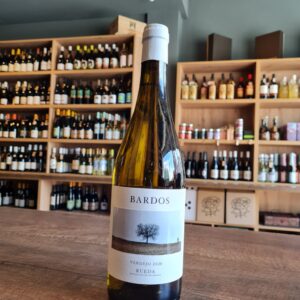 Bardos Verdejo is a wine made from 100% Verdejo from vineyards that are 20-25 years old, located in Rueda, at more than 700 metres of altitude on stony soils. The harvest is carried out at night, at temperatures below 15ºC. The fermentation is done with local yeasts at a controlled temperature and the wine rests on its lees for at least 4 months, gaining complexity and texture. On the nose, the intense aromas of fruit such as white peach combine with cut grass, citrus, balsamic and mineral notes. In the mouth it has a good volume and persistence, well integrated acidity and a characteristic aniseed aftertaste, typical of the grape. Really a high quality example of this native Spanish variety. Excellent with light bites, starters, salads and white fish. All of the wines by De Bardos are crafted by hand in a fully artisan manner.
Bardos Verdejo is a wine made from 100% Verdejo from vineyards that are 20-25 years old, located in Rueda, at more than 700 metres of altitude on stony soils. The harvest is carried out at night, at temperatures below 15ºC. The fermentation is done with local yeasts at a controlled temperature and the wine rests on its lees for at least 4 months, gaining complexity and texture. On the nose, the intense aromas of fruit such as white peach combine with cut grass, citrus, balsamic and mineral notes. In the mouth it has a good volume and persistence, well integrated acidity and a characteristic aniseed aftertaste, typical of the grape. Really a high quality example of this native Spanish variety. Excellent with light bites, starters, salads and white fish. All of the wines by De Bardos are crafted by hand in a fully artisan manner. -
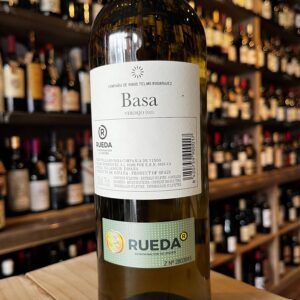
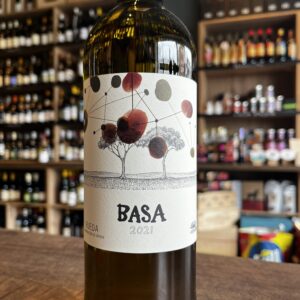 Telmo Rodriguez of Basque origin, studied wine at the Institute of Oenology in Bordeaux, before doing internships with Cos d’Estournel, Jean Louis Chave and Trevallon . He also worked in the vinification of wines from the family estate of Remelluri, in Rioja. Then, in 1990, with an investment of just a few thousand euros, he launched his own winery. He buys grapes to produce his first wines. His first plots of property did not arrive until 1997, in Rioja. Paradoxical for someone who was dying to explore new regions. One of the main principles of Telmo Rodriguez is that of respecting the Spanish tradition of cultivating the vine in goblet, because this method of managing the vine protects it from the great heat of Iberian vineyards. He is fiercely opposed to the fashion of trellising vineyards and only buys vines that respect his ideal. Telmo also works in biodynamics but, showing great common sense, he admits that he only does it for the respect of the land and that the mention of organic viticulture has no importance in his eyes. The important thing is that the result is a balanced and tasty wine. The name comes from the 40-year-old 'baso' or bush-trained vines that are planted on limestone-rich soils at over 700-meters elevation on a plateau along the Duero River. Soils are made of gravel from fluvial terraces, erosion slopes and glacis. Pairs great with comfort food, Tapas and Tortillas of all sorts
Telmo Rodriguez of Basque origin, studied wine at the Institute of Oenology in Bordeaux, before doing internships with Cos d’Estournel, Jean Louis Chave and Trevallon . He also worked in the vinification of wines from the family estate of Remelluri, in Rioja. Then, in 1990, with an investment of just a few thousand euros, he launched his own winery. He buys grapes to produce his first wines. His first plots of property did not arrive until 1997, in Rioja. Paradoxical for someone who was dying to explore new regions. One of the main principles of Telmo Rodriguez is that of respecting the Spanish tradition of cultivating the vine in goblet, because this method of managing the vine protects it from the great heat of Iberian vineyards. He is fiercely opposed to the fashion of trellising vineyards and only buys vines that respect his ideal. Telmo also works in biodynamics but, showing great common sense, he admits that he only does it for the respect of the land and that the mention of organic viticulture has no importance in his eyes. The important thing is that the result is a balanced and tasty wine. The name comes from the 40-year-old 'baso' or bush-trained vines that are planted on limestone-rich soils at over 700-meters elevation on a plateau along the Duero River. Soils are made of gravel from fluvial terraces, erosion slopes and glacis. Pairs great with comfort food, Tapas and Tortillas of all sorts -
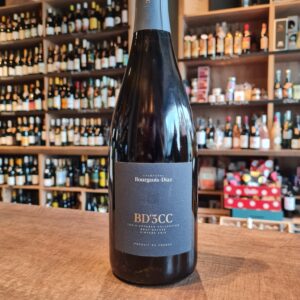 Located in Crouttes-sur-Marne, about 25km east of Meaux, the Bourgeois Diaz vineyard comprises 6.80 hectares of vines, of which 3.5 hectares are planted with Pinot Meunier, 2 with Pinot Noir and 1.3 with Chardonnay. The vines are on average 40 years old and have their roots in soils of clay, silt and chalk . Jérôme is the fourth generation of winegrowers on his father's side. His wife Charlotte, joined the estate in 2016, and today plays an important role in overseeing the estate, helping to develop the quality of the Champagnes. No pesticides, no chemical fertilizers, no technological manipulation, the wines of Jérôme and Charlotte are not only cared for, they are loved. The estate has been certified in organic and biodynamic viticulture since 2014. The biodynamic preparations 5 00P (twice a year) and 501 (3 to 4 times a year) are combined with low doses of copper and sulfur, horsetail decoctions, nettle, wicker, meadowsweet, chamomile, yarrow herbal teas, etc. Green manures are sown every other row, and an agro-forestry project was launched in 2019 (planting of 50 trees in a plot of 45 ares). Most of the work is done manually, foot by foot, to bring the maximum attention to the vines, which explains why the estate employs almost one person per hectare year-round. The harvest is manual, and most of the pickers are regulars, knowing the terroir and the state of mind of the estate. The bunches are harvested when ripe and sorted, so as to bring in grapes only in perfect sanitary condition. Disgorged on 01/12/2019 after 5 years of ageing, this non-dosed brut nature Champagne is straight, ample and deep, with great complexity brought by the long aging in the bottle Pair it with Lobster, bar carpaccio, lean tartare, Saint-Pierre, sweetbreads. Salut!!
Located in Crouttes-sur-Marne, about 25km east of Meaux, the Bourgeois Diaz vineyard comprises 6.80 hectares of vines, of which 3.5 hectares are planted with Pinot Meunier, 2 with Pinot Noir and 1.3 with Chardonnay. The vines are on average 40 years old and have their roots in soils of clay, silt and chalk . Jérôme is the fourth generation of winegrowers on his father's side. His wife Charlotte, joined the estate in 2016, and today plays an important role in overseeing the estate, helping to develop the quality of the Champagnes. No pesticides, no chemical fertilizers, no technological manipulation, the wines of Jérôme and Charlotte are not only cared for, they are loved. The estate has been certified in organic and biodynamic viticulture since 2014. The biodynamic preparations 5 00P (twice a year) and 501 (3 to 4 times a year) are combined with low doses of copper and sulfur, horsetail decoctions, nettle, wicker, meadowsweet, chamomile, yarrow herbal teas, etc. Green manures are sown every other row, and an agro-forestry project was launched in 2019 (planting of 50 trees in a plot of 45 ares). Most of the work is done manually, foot by foot, to bring the maximum attention to the vines, which explains why the estate employs almost one person per hectare year-round. The harvest is manual, and most of the pickers are regulars, knowing the terroir and the state of mind of the estate. The bunches are harvested when ripe and sorted, so as to bring in grapes only in perfect sanitary condition. Disgorged on 01/12/2019 after 5 years of ageing, this non-dosed brut nature Champagne is straight, ample and deep, with great complexity brought by the long aging in the bottle Pair it with Lobster, bar carpaccio, lean tartare, Saint-Pierre, sweetbreads. Salut!! -
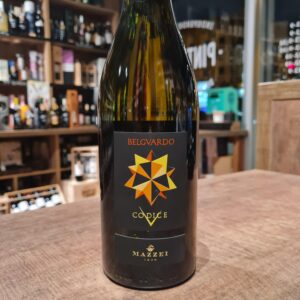 That of the Mazzei is one of the longest and most structured stories that wine Tuscany can give. A story that has as its fulcrum the Chianti Classico and precisely the Castello di Fonterutoli; today a modern cellar with 117 hectares of vineyards for a production of 800,000 bottles. But also a story, made up of great personalities such as, to stay in the near future, Lapo Mazzei, in a period of strong changes, at the same time lays the foundations of today's company. Today, at the helm of this company are the sons Filippi and Francesco who over time have achieved significant goals and given the company a broader scope starting with some acquisitions, even outside Tuscany. In the mid-90s, however, the Belguardo estate project in Maremma was born, with 34 hectares of vineyards. From here comes a non-trivial variation of Vermentino, now it has become the main vine of the Tuscan coast. The white Vermentino "Codice V" of the Belguardo estate of the Mazzei family is a wine born in the heart of the Maremma, on the hills of Grosseto and Montiano. The vines were planted with Vermentino clones originating from Corsica, on loose soils with a predominantly sandy matrix, facing south, south-west. Fermentation takes place in steel tanks at low temperatures and for 20% of the mass in terracotta dolium with maceration on the skins for 4 months. Before final assembly and bottling, the wine rests in steel and terracotta for a few months. on the hills of Grosseto and Montiano. Recommended with fish and white meat savoury dishes, risotto, porcini mushrooms. A tutti!
That of the Mazzei is one of the longest and most structured stories that wine Tuscany can give. A story that has as its fulcrum the Chianti Classico and precisely the Castello di Fonterutoli; today a modern cellar with 117 hectares of vineyards for a production of 800,000 bottles. But also a story, made up of great personalities such as, to stay in the near future, Lapo Mazzei, in a period of strong changes, at the same time lays the foundations of today's company. Today, at the helm of this company are the sons Filippi and Francesco who over time have achieved significant goals and given the company a broader scope starting with some acquisitions, even outside Tuscany. In the mid-90s, however, the Belguardo estate project in Maremma was born, with 34 hectares of vineyards. From here comes a non-trivial variation of Vermentino, now it has become the main vine of the Tuscan coast. The white Vermentino "Codice V" of the Belguardo estate of the Mazzei family is a wine born in the heart of the Maremma, on the hills of Grosseto and Montiano. The vines were planted with Vermentino clones originating from Corsica, on loose soils with a predominantly sandy matrix, facing south, south-west. Fermentation takes place in steel tanks at low temperatures and for 20% of the mass in terracotta dolium with maceration on the skins for 4 months. Before final assembly and bottling, the wine rests in steel and terracotta for a few months. on the hills of Grosseto and Montiano. Recommended with fish and white meat savoury dishes, risotto, porcini mushrooms. A tutti! -
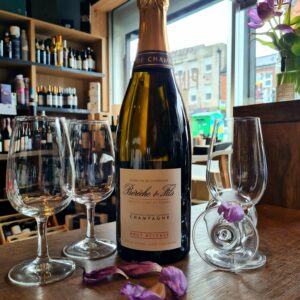 In one of mine first wine classes, the teacher said regarding pairing wines with meals. ''You can attempt everything, and please please do so, but don't matter what you will try, you will see that there is only one type of wine that will pair beautifully with all the meals throughout the day. that wine is Champagne!''. Oh dear was he right...Pair this one with a lovely cooked breakfast and you in for a treat. As for the background of this wine: Raphaël and Vincent Bérêche, two of Champagne’s rising stars, have been working alongside their father Jean-Pierre at their nine-hectare estate of Bérêche et Fils since 2004, and today they are putting an increasingly personal stamp on this thoughtfully-run Domaine. The Bérêche estate owns vines in several different sectors of Champagne, with the three primary areas being the immediate vicinity around Ludes and Craon de Ludes, the gravelly terroir of Ormes in the Petite Montagne, and the area around Mareuil-le-Port, on the left bank of the Vallée de la Marne. A small parcel is also found in Trépail, in the eastern Montagne de Reims. Most recently, the estate has acquired its first grand cru vineyard in 2012, a tiny, 15-are parcel in the village of Mailly. The estate's vineyards are planted with roughly equal parts of the three varieties, and increasing attention is being paid to natural viticulture—Bérêche completely stopped using chemical herbicides in 2004 and has planted cover crops in all of the vineyards, and since 2007 a portion of the vineyard is being converted to biodynamics. Sharp-eyed observers will note that beginning in 2013, Bérêche has changed its status from RM (récoltant-manipulant) to NM (négociant-manipulant). This was done for two reasons: the first was to augment the production of the Brut Réserve by about 15 to 20 percent, selecting grapes from three trusted growers in the villages of Ludes, Maily and Rilly-la-Montagne. These grapes will be used exclusively for the Brut Réserve, and the rest of Bérêche's wines remain entirely estate-grown. The second reason was the creation of a négociant range called Crus Sélectionnés, released under the label Raphaël et Vincent Bérêche. These are wines selected from various sources across the Champagne region, designed to illustrate and reflect their respective terroirs, with the first series of wines to be released in 2014. At Bérêche, vinification tends towards the traditional: parcels are vinified separately, with natural yeasts used for smaller tanks and selected yeasts for larger ones. The family has slowly been increasing the percentage of oak used in the cellar, and today about three-quarters of the production is vinified in barrel. The malolactic is systematically avoided, and the wines are bottled around May, without filtration and with a natural cold-settling, achieved by opening all of the cellar’s windows and waiting for three days. Disgorging is still done entirely by hand, and unlike many growers who are embracing the idea of concentrated must for the dosage, Bérèche adamantly prefers a traditional liqueur. Recently the Bérêches have begun to work more with cork for the second fermentation, believing that it results in a wine of more character and complexity. Raphaël’s father was always a firm believer in cork, but it requires a lot of extra work—now that Raphaël and Vincent are working with him at the estate, it’s easier to accomplish. Today, a quarter of the production is bottled with cork instead of capsule, spread over five different cuvées: Les Beaux Regards, Vallée de la Marne Rive Gauche, Le Cran, Reflet d'Antan and the Campania Remensis rosé. Pair it with: Oysters, Grilled fish, Salads, Cheeses, Starters & Canapes
In one of mine first wine classes, the teacher said regarding pairing wines with meals. ''You can attempt everything, and please please do so, but don't matter what you will try, you will see that there is only one type of wine that will pair beautifully with all the meals throughout the day. that wine is Champagne!''. Oh dear was he right...Pair this one with a lovely cooked breakfast and you in for a treat. As for the background of this wine: Raphaël and Vincent Bérêche, two of Champagne’s rising stars, have been working alongside their father Jean-Pierre at their nine-hectare estate of Bérêche et Fils since 2004, and today they are putting an increasingly personal stamp on this thoughtfully-run Domaine. The Bérêche estate owns vines in several different sectors of Champagne, with the three primary areas being the immediate vicinity around Ludes and Craon de Ludes, the gravelly terroir of Ormes in the Petite Montagne, and the area around Mareuil-le-Port, on the left bank of the Vallée de la Marne. A small parcel is also found in Trépail, in the eastern Montagne de Reims. Most recently, the estate has acquired its first grand cru vineyard in 2012, a tiny, 15-are parcel in the village of Mailly. The estate's vineyards are planted with roughly equal parts of the three varieties, and increasing attention is being paid to natural viticulture—Bérêche completely stopped using chemical herbicides in 2004 and has planted cover crops in all of the vineyards, and since 2007 a portion of the vineyard is being converted to biodynamics. Sharp-eyed observers will note that beginning in 2013, Bérêche has changed its status from RM (récoltant-manipulant) to NM (négociant-manipulant). This was done for two reasons: the first was to augment the production of the Brut Réserve by about 15 to 20 percent, selecting grapes from three trusted growers in the villages of Ludes, Maily and Rilly-la-Montagne. These grapes will be used exclusively for the Brut Réserve, and the rest of Bérêche's wines remain entirely estate-grown. The second reason was the creation of a négociant range called Crus Sélectionnés, released under the label Raphaël et Vincent Bérêche. These are wines selected from various sources across the Champagne region, designed to illustrate and reflect their respective terroirs, with the first series of wines to be released in 2014. At Bérêche, vinification tends towards the traditional: parcels are vinified separately, with natural yeasts used for smaller tanks and selected yeasts for larger ones. The family has slowly been increasing the percentage of oak used in the cellar, and today about three-quarters of the production is vinified in barrel. The malolactic is systematically avoided, and the wines are bottled around May, without filtration and with a natural cold-settling, achieved by opening all of the cellar’s windows and waiting for three days. Disgorging is still done entirely by hand, and unlike many growers who are embracing the idea of concentrated must for the dosage, Bérèche adamantly prefers a traditional liqueur. Recently the Bérêches have begun to work more with cork for the second fermentation, believing that it results in a wine of more character and complexity. Raphaël’s father was always a firm believer in cork, but it requires a lot of extra work—now that Raphaël and Vincent are working with him at the estate, it’s easier to accomplish. Today, a quarter of the production is bottled with cork instead of capsule, spread over five different cuvées: Les Beaux Regards, Vallée de la Marne Rive Gauche, Le Cran, Reflet d'Antan and the Campania Remensis rosé. Pair it with: Oysters, Grilled fish, Salads, Cheeses, Starters & Canapes -
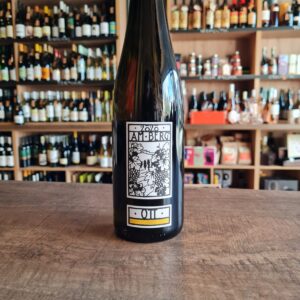 The Ott family has been growing and producing wine in the region of Wagram in Lower Austria since 1889. Bernhard Ott is of the fourth generation and has managed the winery since 1993, when he took the helm from his father. When he came home to the winery as a 21 year old, he was interested in producing wines of the highest quality. Bernhard wanted to prove that elegant and long lived wines could be produced from Grüner Veltliner grown on loess soil, specifically from Rosenberg vineyard. Bernhard replaced the old wooden casks with stainless steel and began working the vineyards with an aim for the highest high quality. In 2004 Benhard began composting, using organic cow manure from a friend in the region. In the past four years he’s used so much manure that the EU contacted him; “they didnt think it was possible to use 100,000 Euros worth of manure – they thought there was some accounting mistake. In 2006 he took a trip to the legendary biodynamic property Domaine La Romanée Conti in Vosne, with his best friend, Hans Reisetbauer. There, after a marathon tasting in the cellars with Aubert de Villaine, Bernhard committed to move to biodynamic viticulture. In 2007, with Johannes Hirsch, Fred Loimer and a group of like-minded producers, Respekt was formed. In 2014, after a very difficult harvest in which Bernhard didn’t bottle any single vineyard wines, he decided to work whole cluster saying “the stem is part of the grape. If you work without stems, you get more sweetness, more round fruit.” Today, Bernhard is looking back to previous generations for inspiration and to inform both his work in the vineyard and in the cellar. Grapes are picked at full ripeness, but thanks to biodynamic farming and composting, the sugar ripeness stays very moderate. “The compost helps with water regulation. Healthy soils give water when the weather is dry and take it back when there is too much. This also means no irrigation at all.” says Bernhard. In addition to working the soils with compost, Bernhard is a firm believer in not disrupting the eco-sysytem under the soils too much, preferring to plowing only 8cm deep. Harvest is done 100% by hand, something that is very important to note in a region who’s rolling hills and flatter landscape allow for machine harvesting. After picking and a strickt selection, the fruit is crushed in the press and maceration is done inside the press. The length of the maceration depends on the vintage, but also on the vineyard and the quality of the fruit. Bernhard uses closed pneumatic presses and has several different sizes. “This is how the press used to operate – there was only one pressing per day, so there was a maceration in the press.” explains Berhard. The juice is “browned” and racked into stainless steel where it is fermented by native yeasts without temperature control. Minimal amounts of sulfur are used at harvest and bottling and the cellar is very cold, inhibiting the development of malolactic. The single vineyard wines from the three Erste Lagen – Rosenberg, Spiegel and Stein – are on the full less until June or July before racking and bottling. The resulting wines are some of the very finest in Austria, straddling a juicy character with strong soil signatures.
The Ott family has been growing and producing wine in the region of Wagram in Lower Austria since 1889. Bernhard Ott is of the fourth generation and has managed the winery since 1993, when he took the helm from his father. When he came home to the winery as a 21 year old, he was interested in producing wines of the highest quality. Bernhard wanted to prove that elegant and long lived wines could be produced from Grüner Veltliner grown on loess soil, specifically from Rosenberg vineyard. Bernhard replaced the old wooden casks with stainless steel and began working the vineyards with an aim for the highest high quality. In 2004 Benhard began composting, using organic cow manure from a friend in the region. In the past four years he’s used so much manure that the EU contacted him; “they didnt think it was possible to use 100,000 Euros worth of manure – they thought there was some accounting mistake. In 2006 he took a trip to the legendary biodynamic property Domaine La Romanée Conti in Vosne, with his best friend, Hans Reisetbauer. There, after a marathon tasting in the cellars with Aubert de Villaine, Bernhard committed to move to biodynamic viticulture. In 2007, with Johannes Hirsch, Fred Loimer and a group of like-minded producers, Respekt was formed. In 2014, after a very difficult harvest in which Bernhard didn’t bottle any single vineyard wines, he decided to work whole cluster saying “the stem is part of the grape. If you work without stems, you get more sweetness, more round fruit.” Today, Bernhard is looking back to previous generations for inspiration and to inform both his work in the vineyard and in the cellar. Grapes are picked at full ripeness, but thanks to biodynamic farming and composting, the sugar ripeness stays very moderate. “The compost helps with water regulation. Healthy soils give water when the weather is dry and take it back when there is too much. This also means no irrigation at all.” says Bernhard. In addition to working the soils with compost, Bernhard is a firm believer in not disrupting the eco-sysytem under the soils too much, preferring to plowing only 8cm deep. Harvest is done 100% by hand, something that is very important to note in a region who’s rolling hills and flatter landscape allow for machine harvesting. After picking and a strickt selection, the fruit is crushed in the press and maceration is done inside the press. The length of the maceration depends on the vintage, but also on the vineyard and the quality of the fruit. Bernhard uses closed pneumatic presses and has several different sizes. “This is how the press used to operate – there was only one pressing per day, so there was a maceration in the press.” explains Berhard. The juice is “browned” and racked into stainless steel where it is fermented by native yeasts without temperature control. Minimal amounts of sulfur are used at harvest and bottling and the cellar is very cold, inhibiting the development of malolactic. The single vineyard wines from the three Erste Lagen – Rosenberg, Spiegel and Stein – are on the full less until June or July before racking and bottling. The resulting wines are some of the very finest in Austria, straddling a juicy character with strong soil signatures. -
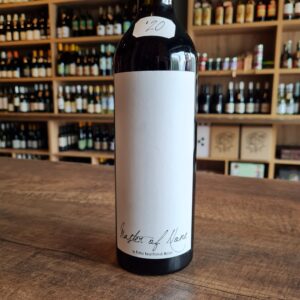 Master of none - Playing with words referring to themselves not being an expert in any one varietal or wine style hence the saying: “Jack of all trades, master of none”. Clever and humble, nonetheless, their wines are at the forefront not only of South Africa but in the world with the amazing wines they are producing. If you enjoy reds on the lighter end of the spectrum such as Pinot Noir or Gamay then Pieter's 'Master of None' will definitely be up your street! It comprises a blend of 5 different grape varieties from tiny vineyard plots across 6 distinct regions; 40% Grenache from Wellington, 30% Cinsault from sites in Darling and Stellenbosch, 8% Pinot Noir from Elgin and a further 8% Syrah from Swartland. Unusually, Pieter then tops up the blend with Voor Paardeberg Chenin Blanc, adding aromatic freshness to the finished wine. It drinks like a top-class Beaujolais – super bright and juicy, bursting with wild strawberry, cherry and with an earthy, smoky undercurrent. Enjoy at room temperature or slightly chilled – perfect for summer drinking! “In 2004, a lady came to my house to buy wine. She asked for anything but Shiraz. “I don’t drink Shiraz”, were her exact words. I poured her a glass of wine. She loved it and bought 3 cases. It was a straight Shiraz. It’s a fact – we do judge the book by its cover.”
Master of none - Playing with words referring to themselves not being an expert in any one varietal or wine style hence the saying: “Jack of all trades, master of none”. Clever and humble, nonetheless, their wines are at the forefront not only of South Africa but in the world with the amazing wines they are producing. If you enjoy reds on the lighter end of the spectrum such as Pinot Noir or Gamay then Pieter's 'Master of None' will definitely be up your street! It comprises a blend of 5 different grape varieties from tiny vineyard plots across 6 distinct regions; 40% Grenache from Wellington, 30% Cinsault from sites in Darling and Stellenbosch, 8% Pinot Noir from Elgin and a further 8% Syrah from Swartland. Unusually, Pieter then tops up the blend with Voor Paardeberg Chenin Blanc, adding aromatic freshness to the finished wine. It drinks like a top-class Beaujolais – super bright and juicy, bursting with wild strawberry, cherry and with an earthy, smoky undercurrent. Enjoy at room temperature or slightly chilled – perfect for summer drinking! “In 2004, a lady came to my house to buy wine. She asked for anything but Shiraz. “I don’t drink Shiraz”, were her exact words. I poured her a glass of wine. She loved it and bought 3 cases. It was a straight Shiraz. It’s a fact – we do judge the book by its cover.” -
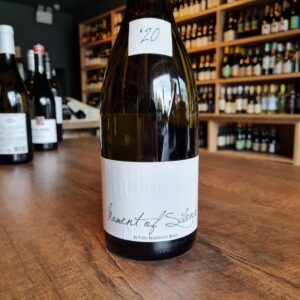 Moment of Silence is a South African wine made by superstar wine maker Pieter Walser. He buys in the fruit to make this blended wine of Viognier, Chenin Blanc and Chardonnay. It has been aged in old oak and it is a rich, powerful wine. Some of the fruit comes from vineyards which are over 50 years old.Stunning, all rounder, there is nothing you can fault in this wine. Aromas of candied lemon, cooked apple and mango with a core of minerality. Soft and voluptuous, it has a lovely ripeness and a fleshy, creamy mouthfeel, which leads to a perfect tangy freshness giving some zip to its otherwise mellow feel.
Moment of Silence is a South African wine made by superstar wine maker Pieter Walser. He buys in the fruit to make this blended wine of Viognier, Chenin Blanc and Chardonnay. It has been aged in old oak and it is a rich, powerful wine. Some of the fruit comes from vineyards which are over 50 years old.Stunning, all rounder, there is nothing you can fault in this wine. Aromas of candied lemon, cooked apple and mango with a core of minerality. Soft and voluptuous, it has a lovely ripeness and a fleshy, creamy mouthfeel, which leads to a perfect tangy freshness giving some zip to its otherwise mellow feel. -
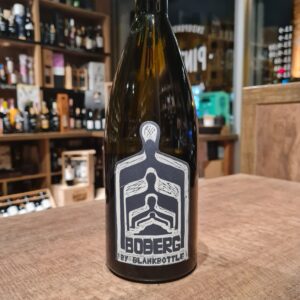 Pieter Walser from Blankbottle has got to be one of the most interesting, inspired, and avant-garde winemakers there is. His wine background mounts to college when he drove past a winery that had bottles with no labels on offer and he could only afford 3 cases. Went back and sold the 3 at a profit. That very moment started a fascinating story that would inspire any of us. As per his own words: “Moment of Silence predominantly comes from a farm in Wellington called Twyfeling. Boberg is situated on a farm right next to Twyfeling and literally looks onto the vineyards of Twyfeling. Now Twyfeling was owned by my direct family seven generations ago. So on the label it shows 7 generations with Boberg overlooking all seven generations of the Hauptfleisch family. 2015 was the first year that I bought the grapes from this Vineyard. The Farmer calls the vineyard BOBERG, which means “on top of the Mountain”. It was a neglected little vineyard, old bush vines with no irrigation. The farmer identified it as a site with potential and started with a restoration process. The vineyard grows in decomposed granitic soil in Wellington. The site is cooler than the others in the area.
Pieter Walser from Blankbottle has got to be one of the most interesting, inspired, and avant-garde winemakers there is. His wine background mounts to college when he drove past a winery that had bottles with no labels on offer and he could only afford 3 cases. Went back and sold the 3 at a profit. That very moment started a fascinating story that would inspire any of us. As per his own words: “Moment of Silence predominantly comes from a farm in Wellington called Twyfeling. Boberg is situated on a farm right next to Twyfeling and literally looks onto the vineyards of Twyfeling. Now Twyfeling was owned by my direct family seven generations ago. So on the label it shows 7 generations with Boberg overlooking all seven generations of the Hauptfleisch family. 2015 was the first year that I bought the grapes from this Vineyard. The Farmer calls the vineyard BOBERG, which means “on top of the Mountain”. It was a neglected little vineyard, old bush vines with no irrigation. The farmer identified it as a site with potential and started with a restoration process. The vineyard grows in decomposed granitic soil in Wellington. The site is cooler than the others in the area. -
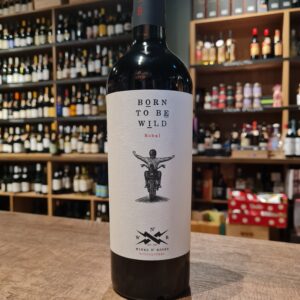 Mars Bonfire, Steppenwolf’s drummer’s brother, saw a poster which said,” Born To Ride” with a photo of a motorbike taking off from the ground surrounded by fire. Around that time, he had bought his first car and that’s how the idea came about to celebrate the freedom of being able to go where you want and when you want. NASA used “Born To Be Wild” to wake up their astronaut crews. And when a spaceship landed for the first time on Mars the small exploratory vehicle went down the ramp to the rhythm of “Get your motor running”. In 2004 Paris Hilton asked permission to use the song in her reality show The Simple Life. The band refused.” There are things Rock’n’Roll can’t accept.” The organic Bobal grapes are grown in poor clay soils situated in the west of the province of Valencia at 700 metres altitude. The vines grow in a ‘continental’ climate influenced by the Mediterranean. The wine spends 9 months in French and American oak barrels. Best enjoyed relaxing and/or with pasta, rice and red meat dishes. The Bobal grape variety has really high levels of resveratrol, an antioxidant and a heart healthy polyphenol, which helps metabolise fats.
Mars Bonfire, Steppenwolf’s drummer’s brother, saw a poster which said,” Born To Ride” with a photo of a motorbike taking off from the ground surrounded by fire. Around that time, he had bought his first car and that’s how the idea came about to celebrate the freedom of being able to go where you want and when you want. NASA used “Born To Be Wild” to wake up their astronaut crews. And when a spaceship landed for the first time on Mars the small exploratory vehicle went down the ramp to the rhythm of “Get your motor running”. In 2004 Paris Hilton asked permission to use the song in her reality show The Simple Life. The band refused.” There are things Rock’n’Roll can’t accept.” The organic Bobal grapes are grown in poor clay soils situated in the west of the province of Valencia at 700 metres altitude. The vines grow in a ‘continental’ climate influenced by the Mediterranean. The wine spends 9 months in French and American oak barrels. Best enjoyed relaxing and/or with pasta, rice and red meat dishes. The Bobal grape variety has really high levels of resveratrol, an antioxidant and a heart healthy polyphenol, which helps metabolise fats. -
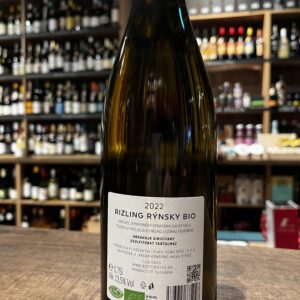
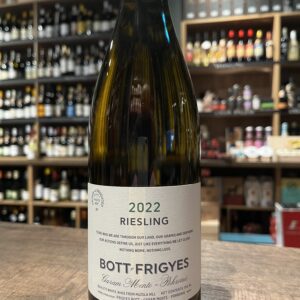 A beautifully clean biodynamic Riesling that will shock most enthusiasts and wine experts alike. Charming honied peaches on the nose, yet a superbly elegant and dry palate of great intensity and length. Spontaneous fermentation and 9 months on the lees in Stockinger barrels add complexity, while the great reductive strength comes from the volcanic terroir. Bott Frigyes is a tiny family producer in Southern Slovakia, who takes the Burgundian approach and quality to winemaking with a Central European twist. Pair it with Iberico pork chops grilled on the bone, finished in thyme infused butter. Sensational.
A beautifully clean biodynamic Riesling that will shock most enthusiasts and wine experts alike. Charming honied peaches on the nose, yet a superbly elegant and dry palate of great intensity and length. Spontaneous fermentation and 9 months on the lees in Stockinger barrels add complexity, while the great reductive strength comes from the volcanic terroir. Bott Frigyes is a tiny family producer in Southern Slovakia, who takes the Burgundian approach and quality to winemaking with a Central European twist. Pair it with Iberico pork chops grilled on the bone, finished in thyme infused butter. Sensational. -
Out of stock
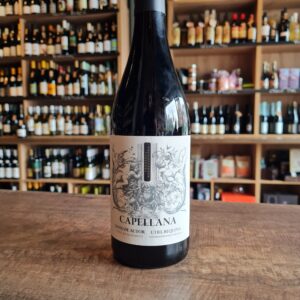 This complex and medium to full-bodied wine is made from Cabernet Sauvignon and Tempranillo grapes. It matured for 7 months in American oak barrels to its full taste. The Cabernet brings strength and abundance here, Tempranillo provides fruit and structure. The result is a wine with character and personality. Cherry juice-colored to brick-red in the glass. Overwhelming scent of cherries, plums and wild berries; the same fruits pickled in rum, all nobly underlaid with fine toasted notes from the wooden barrel. The oak wood is noticeable, but does not dominate the wine. In the mouth the wine is well structured, full and with little surprising tannins. Ideal to accompany grilled meats and different types of stews.
This complex and medium to full-bodied wine is made from Cabernet Sauvignon and Tempranillo grapes. It matured for 7 months in American oak barrels to its full taste. The Cabernet brings strength and abundance here, Tempranillo provides fruit and structure. The result is a wine with character and personality. Cherry juice-colored to brick-red in the glass. Overwhelming scent of cherries, plums and wild berries; the same fruits pickled in rum, all nobly underlaid with fine toasted notes from the wooden barrel. The oak wood is noticeable, but does not dominate the wine. In the mouth the wine is well structured, full and with little surprising tannins. Ideal to accompany grilled meats and different types of stews. -
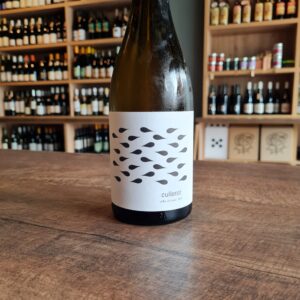 Celler del Roure is making very interesting wines with local grape varieties in the Valencia area. Many of these old, indigenous varieties are largely forgotten and Cullerot highlights three of them (Verdil, Tortosina, and Merseguera) together with Pedro Ximénez, Macabeo, Malvasía, and others. In addition to their focus on indigenous grape varieties, Celler del Roure is employing traditional vinifications methods: hand harvesting, fermenting with native yeasts in stone lagars, and aging in very old clay amphorae. Cullerot has a bit of skin contact, and is medium bodied with notes of stone fruit, tropical notes, apple skin, and clay-y minerality. A great, truly interesting, "almost-orange" skin contact white wine, for less than €20.
Celler del Roure is making very interesting wines with local grape varieties in the Valencia area. Many of these old, indigenous varieties are largely forgotten and Cullerot highlights three of them (Verdil, Tortosina, and Merseguera) together with Pedro Ximénez, Macabeo, Malvasía, and others. In addition to their focus on indigenous grape varieties, Celler del Roure is employing traditional vinifications methods: hand harvesting, fermenting with native yeasts in stone lagars, and aging in very old clay amphorae. Cullerot has a bit of skin contact, and is medium bodied with notes of stone fruit, tropical notes, apple skin, and clay-y minerality. A great, truly interesting, "almost-orange" skin contact white wine, for less than €20. -
Out of stock
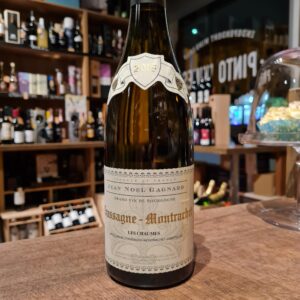 This famous Domaine has been run by Caroline Lestimé, Jean-Noël’s daughter, since 1989. Its 12.5 hectares of outstanding vineyards have been certified organic since 2014, and are now run biodynamically, though are not yet certified as such. Most of the estate’s vineyards are in the heart of Chassagne, with one vineyard in the Hautes Côtes de Beaune, which looks down on St. Aubin and was planted in 2015 at an altitude of 300 metres above sea level. The vines are Guyot-trained and planted on a moderate hill facing east. The soils here are stony calcareous clays which are enriched with biodynamic composts at the end of every winter. The wines are, in the best sense of the phrase, ‘low intervention’ wines, with each expressing the character of its site. The 2018 vintage started with good levels of winter rainfall, replenishing the soil moisture content. After a cold February and a rainy March, conditions in April were warm and dry, allowing the vineyard growth to catch up after the earlier delays. Flowering occurred under perfect conditions and summer brought consistently warm, sunny days through to harvest, which took place on August 26th. Grapes for this wine come from two similar plots: one parcel is in the upper part of the appellation (just under the road to Santenay) and the other on the lower part. 40 year old Vines Approximately 200 cases of this cuvée are made each year. Great wine to be appreciated. being an elegant and with layers of structure making this wine quite exquisite. Decanter highly recommended here.
This famous Domaine has been run by Caroline Lestimé, Jean-Noël’s daughter, since 1989. Its 12.5 hectares of outstanding vineyards have been certified organic since 2014, and are now run biodynamically, though are not yet certified as such. Most of the estate’s vineyards are in the heart of Chassagne, with one vineyard in the Hautes Côtes de Beaune, which looks down on St. Aubin and was planted in 2015 at an altitude of 300 metres above sea level. The vines are Guyot-trained and planted on a moderate hill facing east. The soils here are stony calcareous clays which are enriched with biodynamic composts at the end of every winter. The wines are, in the best sense of the phrase, ‘low intervention’ wines, with each expressing the character of its site. The 2018 vintage started with good levels of winter rainfall, replenishing the soil moisture content. After a cold February and a rainy March, conditions in April were warm and dry, allowing the vineyard growth to catch up after the earlier delays. Flowering occurred under perfect conditions and summer brought consistently warm, sunny days through to harvest, which took place on August 26th. Grapes for this wine come from two similar plots: one parcel is in the upper part of the appellation (just under the road to Santenay) and the other on the lower part. 40 year old Vines Approximately 200 cases of this cuvée are made each year. Great wine to be appreciated. being an elegant and with layers of structure making this wine quite exquisite. Decanter highly recommended here. -
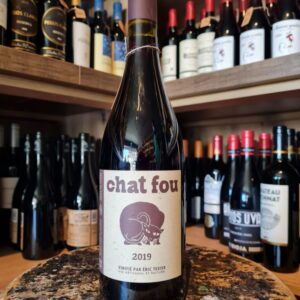 If you were ever sceptical about Organic wines, you have to give this one a try! This wine is Artisanal, Organic, Biodynamic, unfined and unfiltered. All with the aim to do as little intervention as possible and to let the Terroir speak for itself. Eric Texier Chat Fou natural red wine is a coupage of Grenache Tinta, Clairette and Marsanne, from the well known region of Côtes du Rhône.Eric Texier is a vigneron from Brézème, a municipality in the northern area of the Rhone Valley. Texier worked in nuclear engineering but switched to the world of wine in the early 1990s. He practices minimal viticulture and oenology, and attaches special importance to the management of the soils of his vineyards. The result is this superb wine a true example of natural wines and at the forefront of this movement. Eric is not a follower of fashion and speaks vehemently against those who label themselves as natural when it is used as a marketing tool rather than a true desire to understand the terroir. He believes that in most cases all natural wines taste the same! He vinifies all his wines in the same way, using as little intervention as possible to allow the terroir of his different parcels to do the talking. Hope it catches your eye!
If you were ever sceptical about Organic wines, you have to give this one a try! This wine is Artisanal, Organic, Biodynamic, unfined and unfiltered. All with the aim to do as little intervention as possible and to let the Terroir speak for itself. Eric Texier Chat Fou natural red wine is a coupage of Grenache Tinta, Clairette and Marsanne, from the well known region of Côtes du Rhône.Eric Texier is a vigneron from Brézème, a municipality in the northern area of the Rhone Valley. Texier worked in nuclear engineering but switched to the world of wine in the early 1990s. He practices minimal viticulture and oenology, and attaches special importance to the management of the soils of his vineyards. The result is this superb wine a true example of natural wines and at the forefront of this movement. Eric is not a follower of fashion and speaks vehemently against those who label themselves as natural when it is used as a marketing tool rather than a true desire to understand the terroir. He believes that in most cases all natural wines taste the same! He vinifies all his wines in the same way, using as little intervention as possible to allow the terroir of his different parcels to do the talking. Hope it catches your eye! -
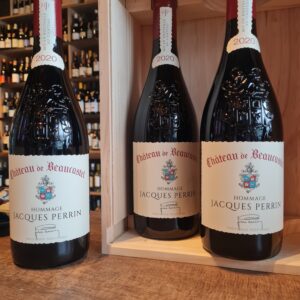 The Perrin family of Châteauneuf-du-Pape are one of the Rhône Valley’s greatest vineyard owners. With over 200 hectares of top level, prime vineyards at their fingertips, they have the terroir and skill required to produce some of the region’s finest wines. The estate traces its history back to a plot of Coudoulet vines bought by Pierre de Beaucastel in 1549. The estate was transferred into the Perrin family in 1909 through marriage, where it remains firmly to this day. Despite being one of the old guards of the region, they are also one of the most progressive estates. They were one of the first converts to organic and biodynamic faming in Châteauneuf-du-Pape, which they adopted in 1950 and 1974 respectively. A legendary Châteauneuf-du-Pape wine, Hommage à Jacques Perrin by Château de Beaucastel is one of the world's greatest wines. It brilliantly embodies the motto of the Perrin family: "A Grand Vin embodies emotion and civilisation, a legend that transcends time." The first vintage of this prestigious wine was produced in 1989. Produced in very limited quantities, the Hommage à Jacques Perrin wine comes from a unique terroir composed of rolled pebbles upon clay-limestone and silt soils in an exceptional vineyard located in the northern part of the Châteauneuf-du-Pape appellation, in the Rhône Valley. Vintage 2020 was relatively mild, the winter was punctuated by an episode of frost which had little impact on the vineyards, even the earliest plots. While the mildness of spring favoured vegetative development, a constant wind kept the soil cool. The hot, sunny summer was marked by both coolness and temperature variations between day and night, ideal conditions for ensuring a high-quality and even ripening of the grapes. Harvested at perfect maturity, the juicy and balanced grapes gave rise to a fine vintage.
The Perrin family of Châteauneuf-du-Pape are one of the Rhône Valley’s greatest vineyard owners. With over 200 hectares of top level, prime vineyards at their fingertips, they have the terroir and skill required to produce some of the region’s finest wines. The estate traces its history back to a plot of Coudoulet vines bought by Pierre de Beaucastel in 1549. The estate was transferred into the Perrin family in 1909 through marriage, where it remains firmly to this day. Despite being one of the old guards of the region, they are also one of the most progressive estates. They were one of the first converts to organic and biodynamic faming in Châteauneuf-du-Pape, which they adopted in 1950 and 1974 respectively. A legendary Châteauneuf-du-Pape wine, Hommage à Jacques Perrin by Château de Beaucastel is one of the world's greatest wines. It brilliantly embodies the motto of the Perrin family: "A Grand Vin embodies emotion and civilisation, a legend that transcends time." The first vintage of this prestigious wine was produced in 1989. Produced in very limited quantities, the Hommage à Jacques Perrin wine comes from a unique terroir composed of rolled pebbles upon clay-limestone and silt soils in an exceptional vineyard located in the northern part of the Châteauneuf-du-Pape appellation, in the Rhône Valley. Vintage 2020 was relatively mild, the winter was punctuated by an episode of frost which had little impact on the vineyards, even the earliest plots. While the mildness of spring favoured vegetative development, a constant wind kept the soil cool. The hot, sunny summer was marked by both coolness and temperature variations between day and night, ideal conditions for ensuring a high-quality and even ripening of the grapes. Harvested at perfect maturity, the juicy and balanced grapes gave rise to a fine vintage. -
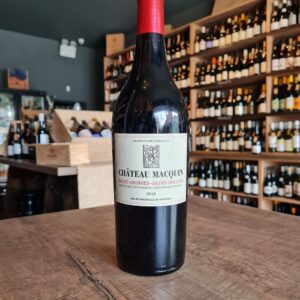 Wines have been made at Château Macquin since 1885, when the first cellar was developed by François-Albert Macquin. François was the first to re-plant vines in the Saint-Émilion region following the phylloxera outbreak in the 19th century. Today, the Château is run by his grandson Denis and wife Christine Corre-Macquin, who own 27 hectares of vines in both Saint-Émilion and Pomerol. They are involved in every vine-growing and winemaking decision to ensure the high quality of their wine remains consistent every vintage. Château Macquin is located just three kilometres north of Saint-Émilion, in the small village of Saint-Georges, the smallest of all Bordeaux appellations (180 hectares). However, at its peak of 89 metres above sea level, Saint-Georges enjoys one of the best elevations on the right bank, giving the wines freshness and concentration. The south facing vines are planted on clay and limestone soils and range from 15 to 60 years old. The vines are sustainably farmed, without the use of herbicides, fertilisers, or other harmful chemicals. The outstanding weather conditions in August and subsequent Indian summer resulted in red wine grapes with a particularly high sugar content, satisfactory levels of tartaric acid and promising aromatic potential. The thick skins and concentration of tannins required meticulous care during extraction. The Merlot wines are deep and concentrated,while maintaining freshness in spite of their relatively high alcohol level. Enjoyed with Ratatouille, Tournedos, grilled lamb chops.
Wines have been made at Château Macquin since 1885, when the first cellar was developed by François-Albert Macquin. François was the first to re-plant vines in the Saint-Émilion region following the phylloxera outbreak in the 19th century. Today, the Château is run by his grandson Denis and wife Christine Corre-Macquin, who own 27 hectares of vines in both Saint-Émilion and Pomerol. They are involved in every vine-growing and winemaking decision to ensure the high quality of their wine remains consistent every vintage. Château Macquin is located just three kilometres north of Saint-Émilion, in the small village of Saint-Georges, the smallest of all Bordeaux appellations (180 hectares). However, at its peak of 89 metres above sea level, Saint-Georges enjoys one of the best elevations on the right bank, giving the wines freshness and concentration. The south facing vines are planted on clay and limestone soils and range from 15 to 60 years old. The vines are sustainably farmed, without the use of herbicides, fertilisers, or other harmful chemicals. The outstanding weather conditions in August and subsequent Indian summer resulted in red wine grapes with a particularly high sugar content, satisfactory levels of tartaric acid and promising aromatic potential. The thick skins and concentration of tannins required meticulous care during extraction. The Merlot wines are deep and concentrated,while maintaining freshness in spite of their relatively high alcohol level. Enjoyed with Ratatouille, Tournedos, grilled lamb chops. -
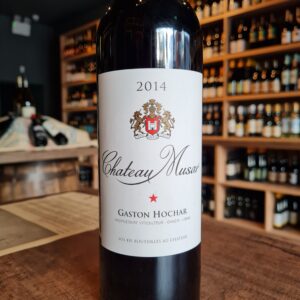 Seven years in the making, Chateau Musar Red is a blend of Cabernet Sauvignon, Carignan and Cinsault from vineyards near the Bekaa Valley villages of Aana and Kefraya on gravelly soils over limestone. Planted from the 1930s onwards, yields are low from these mature bushvines (average age: 40 years):. The varietal components are brought together two years after the harvest; the resulting blend is then placed back in cement tanks before being bottled 12 months later. After 4 years’ bottle maturation in the deep stone cellars of Chateau Musar, the finished wines are released a full seven years after the harvest. Bottled unfined and unfiltered, Chateau Musar Reds are suitable for vegans; they’re also richly-textured and likely to ‘throw a crust’. This is a common feature of most fine wines and is especially true of Musar Red vintages over a decade old. Ideally, bottles should be standing up the night before opening to allow the sediment to settle. After careful decanting (and discarding of sediment, usually in the last centimetre of the bottle) the wine should be allowed to breathe for an hour and served at 18°C with roasts, grills (especially lamb), casseroles, game, and mature cheeses. One of my favourite wines and at somewhate affordable price.
Seven years in the making, Chateau Musar Red is a blend of Cabernet Sauvignon, Carignan and Cinsault from vineyards near the Bekaa Valley villages of Aana and Kefraya on gravelly soils over limestone. Planted from the 1930s onwards, yields are low from these mature bushvines (average age: 40 years):. The varietal components are brought together two years after the harvest; the resulting blend is then placed back in cement tanks before being bottled 12 months later. After 4 years’ bottle maturation in the deep stone cellars of Chateau Musar, the finished wines are released a full seven years after the harvest. Bottled unfined and unfiltered, Chateau Musar Reds are suitable for vegans; they’re also richly-textured and likely to ‘throw a crust’. This is a common feature of most fine wines and is especially true of Musar Red vintages over a decade old. Ideally, bottles should be standing up the night before opening to allow the sediment to settle. After careful decanting (and discarding of sediment, usually in the last centimetre of the bottle) the wine should be allowed to breathe for an hour and served at 18°C with roasts, grills (especially lamb), casseroles, game, and mature cheeses. One of my favourite wines and at somewhate affordable price. -
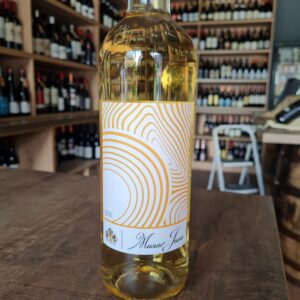 Château Musar is located in the Bekaa Valley, in Lebanon. It was created by Gaston Hochar in 1930 when he was only 20 years-old and inspired by Lebanon’s 6,000-year winemaking tradition and his travels in Bordeaux. Serge Hochar, his son, started producing wines at the end of 1950. His brother, Ronald, joined at the beginning of 1960. In 1975, 97% of the production was sold locally. It picked up after the Bristol Wine Fair of 1979 and, in 1990, at the end of the civil war, the export accounted for 97% of the production. The 3rd generation of the Hochar family started joining in 1994 and is still a family-run-business. Musar Jeune White is an unoaked blend of Viognier, Vermentino, Chardonnay from youthful Bekaa Valley vines. Crisp and aromatic, this eclectic blend of French and Italian varieties has its own distinct personality – passionfruit, apples, elderflowers – and a dry, refreshing finish. No need to decant; enjoy chilled (10-12°C) with grilled fish, herb-scented roast chicken, seafood salads and spicy oriental dishes. All their wines are Organic.
Château Musar is located in the Bekaa Valley, in Lebanon. It was created by Gaston Hochar in 1930 when he was only 20 years-old and inspired by Lebanon’s 6,000-year winemaking tradition and his travels in Bordeaux. Serge Hochar, his son, started producing wines at the end of 1950. His brother, Ronald, joined at the beginning of 1960. In 1975, 97% of the production was sold locally. It picked up after the Bristol Wine Fair of 1979 and, in 1990, at the end of the civil war, the export accounted for 97% of the production. The 3rd generation of the Hochar family started joining in 1994 and is still a family-run-business. Musar Jeune White is an unoaked blend of Viognier, Vermentino, Chardonnay from youthful Bekaa Valley vines. Crisp and aromatic, this eclectic blend of French and Italian varieties has its own distinct personality – passionfruit, apples, elderflowers – and a dry, refreshing finish. No need to decant; enjoy chilled (10-12°C) with grilled fish, herb-scented roast chicken, seafood salads and spicy oriental dishes. All their wines are Organic. -
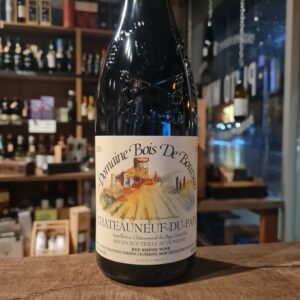 Domaine Bois de Boursan makes exemplary Châteauneuf-du-Pape in the Southern Rhône. This family-run estate was started by the Versino family in 1955, who moved across from Piedmont in Italy. It is now in the hands of Jean-Paul, the third generation at the helm. He takes great pride in continuing to make traditionally-styled reds with the belief that vinifying with stems and ageing the wine for extended periods in large oak foudres gives his wine its unique character. There is nothing flashy or opulent here, just wines with great character. In total, Jean-Paul has 10 hectares spread across 27 different parcels in Châteauneuf-du-Pape, with its changing soil types and vines up to 50 years old.
Domaine Bois de Boursan makes exemplary Châteauneuf-du-Pape in the Southern Rhône. This family-run estate was started by the Versino family in 1955, who moved across from Piedmont in Italy. It is now in the hands of Jean-Paul, the third generation at the helm. He takes great pride in continuing to make traditionally-styled reds with the belief that vinifying with stems and ageing the wine for extended periods in large oak foudres gives his wine its unique character. There is nothing flashy or opulent here, just wines with great character. In total, Jean-Paul has 10 hectares spread across 27 different parcels in Châteauneuf-du-Pape, with its changing soil types and vines up to 50 years old. -
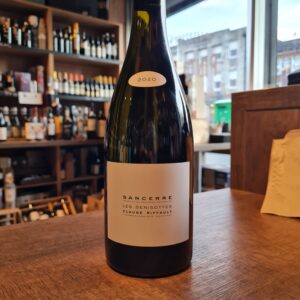 Stéphane Riffault (Claude’s son and now the owner of the estate) is turning out Sancerre bottlings that are the envy of many producers twice his age. As David Schildknecht put it, “Make no mistake: this address in the hamlet of Maison Salle (Sury-en-Vaux) is now one of the five or six most exciting estates in the Sancerre appellation.” Given that Stephane’s holdings represent 4-tenths of 1 percent of the appellation, he is clearly doing something right. Based in the village of Sury-en-Vaux, Stéphane Riffault works 33 different parcels in 8 different lieu-dits spread across four villages. The 13.5 hectares of vines are plowed, and no synthetic material is used. Starting in 2017, the property has been certified organic by ECOCERT and biodynamic by BIODYVIN. Unlike most Sancerre producers, the entire harvest is carried out by hand, and extensive sorting occurs before the grapes are crushed. Stéphane’s wife, Benedicte, leads the harvest team while Stéphane manages the sorting and press during harvest. Most of the domaine’s holdings are planted on the soft limestone soil called terres blanches, with some parcels on calliottes and silex. Minor, judicious uses of oak help to add length to the already precise, site-expressive, and vertical bottlings. All the parcels are vinified separately, and except for the rosé, all the wines are bottled unfiltered. Having studied and worked in Burgundy (and closely with Olivier Leflaive), it’s easy to see the Burgundian influence in Stéphane’s wines. The mastery of minerality standing shoulder–height with the wood is rarely duplicated in Sancerre. Regardless of his parcels’ exposition (many are south-facing), Riffault’s wines are always crisp and highcut with a jeweled delineation that speaks to the precision and attention these wines get. These are not your daddy’s (or his daddy, Claude’s) Sancerres. Sancerre Les Denisottes Les Denisottes comes from a lieu-dit located quite close to the domaine’s cellar. Here the terres blanches soils are deeper and more pebbly than rocky and producing a richer style of Sancerre – one that requires a longer élevage in barrel, and released with a greater capacity to age.
Stéphane Riffault (Claude’s son and now the owner of the estate) is turning out Sancerre bottlings that are the envy of many producers twice his age. As David Schildknecht put it, “Make no mistake: this address in the hamlet of Maison Salle (Sury-en-Vaux) is now one of the five or six most exciting estates in the Sancerre appellation.” Given that Stephane’s holdings represent 4-tenths of 1 percent of the appellation, he is clearly doing something right. Based in the village of Sury-en-Vaux, Stéphane Riffault works 33 different parcels in 8 different lieu-dits spread across four villages. The 13.5 hectares of vines are plowed, and no synthetic material is used. Starting in 2017, the property has been certified organic by ECOCERT and biodynamic by BIODYVIN. Unlike most Sancerre producers, the entire harvest is carried out by hand, and extensive sorting occurs before the grapes are crushed. Stéphane’s wife, Benedicte, leads the harvest team while Stéphane manages the sorting and press during harvest. Most of the domaine’s holdings are planted on the soft limestone soil called terres blanches, with some parcels on calliottes and silex. Minor, judicious uses of oak help to add length to the already precise, site-expressive, and vertical bottlings. All the parcels are vinified separately, and except for the rosé, all the wines are bottled unfiltered. Having studied and worked in Burgundy (and closely with Olivier Leflaive), it’s easy to see the Burgundian influence in Stéphane’s wines. The mastery of minerality standing shoulder–height with the wood is rarely duplicated in Sancerre. Regardless of his parcels’ exposition (many are south-facing), Riffault’s wines are always crisp and highcut with a jeweled delineation that speaks to the precision and attention these wines get. These are not your daddy’s (or his daddy, Claude’s) Sancerres. Sancerre Les Denisottes Les Denisottes comes from a lieu-dit located quite close to the domaine’s cellar. Here the terres blanches soils are deeper and more pebbly than rocky and producing a richer style of Sancerre – one that requires a longer élevage in barrel, and released with a greater capacity to age. -
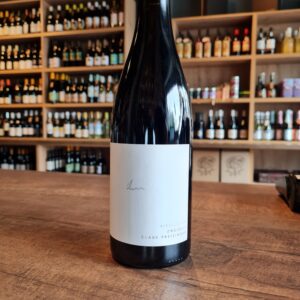 Claus Preisinger has honed his skills around the world, working in vineyards in California, before returning to his Austrian roots to work for Anita and Hans Nittnaus. After branching out on his own, he has kept the respectful and honest winemaking he learned there, and is applying it a stone's throw away in the town of Gols. His "Kieselstein" Zweigelt is one of the most immediately enjoyable wines that I have had the opportunity to drink as of late. This beautifully pure Zweigelt was fermented in neutral barrels with a touch of sulphur added at bottling. Claus Preisinger has been using ambient yeasts since 2002 as well as little to no sulfites. The Preisinger wines are certified biodynamic, which Claus takes very seriously. His commitment to the environment and non-interventional winemaking shines through in the superior wines he produces. Super fresh and juicy. Can be served chilled.
Claus Preisinger has honed his skills around the world, working in vineyards in California, before returning to his Austrian roots to work for Anita and Hans Nittnaus. After branching out on his own, he has kept the respectful and honest winemaking he learned there, and is applying it a stone's throw away in the town of Gols. His "Kieselstein" Zweigelt is one of the most immediately enjoyable wines that I have had the opportunity to drink as of late. This beautifully pure Zweigelt was fermented in neutral barrels with a touch of sulphur added at bottling. Claus Preisinger has been using ambient yeasts since 2002 as well as little to no sulfites. The Preisinger wines are certified biodynamic, which Claus takes very seriously. His commitment to the environment and non-interventional winemaking shines through in the superior wines he produces. Super fresh and juicy. Can be served chilled. -
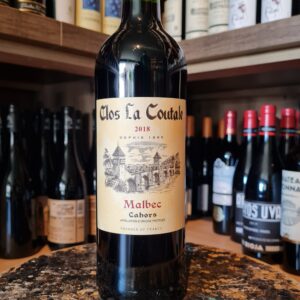 Malbec is the main grape in the legendary ‘Black wine of Cahors’. Way before Argentina made the varietal ‘famous’, Malbec – though in this region it is known as Côt or Auxerrois. – was making long-lived wines from Cahors – the 1959 Clos La Coutale is still drinking superbly. Clos La Coutale is a benchmark of the Cahors region and has a history of producing some of the finest and longest-lived wines of the region. Blackcurrants, blackberry's and prune notes followed by a soft and elegant palate that has an enticing note of vanilla. This Clos La Coutale wine is matured in barrels and wooden casks for one year in order to obtain a good balance between tannins and fruit. Organic and true gem at this price point.
Malbec is the main grape in the legendary ‘Black wine of Cahors’. Way before Argentina made the varietal ‘famous’, Malbec – though in this region it is known as Côt or Auxerrois. – was making long-lived wines from Cahors – the 1959 Clos La Coutale is still drinking superbly. Clos La Coutale is a benchmark of the Cahors region and has a history of producing some of the finest and longest-lived wines of the region. Blackcurrants, blackberry's and prune notes followed by a soft and elegant palate that has an enticing note of vanilla. This Clos La Coutale wine is matured in barrels and wooden casks for one year in order to obtain a good balance between tannins and fruit. Organic and true gem at this price point. -
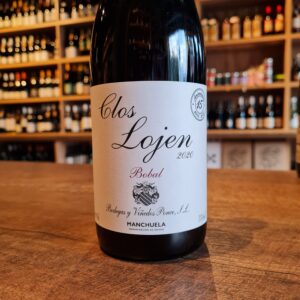 Manchuela is the spiritual home of the Bobal grape. Clos Lojen made by Bodega y Viñedos Ponce is a biodynamic and pure 100% Bobal from limestone soils, fermented in big oak casks. Bobal is the 2nd most planted red variety in Spain yet so little of it reaches the heights of which it’s undoubtedly capable. With a naturally deep colour, high levels of tannins, high acidity and an ability to be exciting as either a blending partner or a mono-varietal wine, momentum needs to be gained with Bobal, till then we seek winemakers that do exciting things and produce wines that are fun to drink. As per Juan Antonio Ponce own words “I want my wines to be bought by any ordinary person. We must be able to reach consumers in a straight-forward manner otherwise beer will cannibalize our markets.”
Manchuela is the spiritual home of the Bobal grape. Clos Lojen made by Bodega y Viñedos Ponce is a biodynamic and pure 100% Bobal from limestone soils, fermented in big oak casks. Bobal is the 2nd most planted red variety in Spain yet so little of it reaches the heights of which it’s undoubtedly capable. With a naturally deep colour, high levels of tannins, high acidity and an ability to be exciting as either a blending partner or a mono-varietal wine, momentum needs to be gained with Bobal, till then we seek winemakers that do exciting things and produce wines that are fun to drink. As per Juan Antonio Ponce own words “I want my wines to be bought by any ordinary person. We must be able to reach consumers in a straight-forward manner otherwise beer will cannibalize our markets.” -
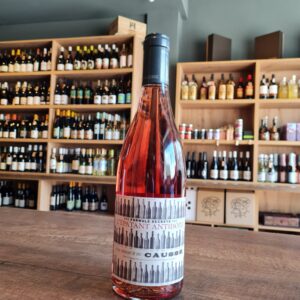 Combel La Serre has been certified organic since 2013, though farmed without chemicals for several decades up to that point. 100% Malbec (known in Cahors as Auxerrois). The vines are 40 years old, grown on clay and limestone soils at an elevation of 320m. Fermentation and aging take place in small tanks."The Splendid Antidote to the Heat of the Causse" is the amusing and appropriate name of this refreshing rosé. (The Causse is the high limestone plateau around Cahors, which gets brutally hot in the summer.) The wine shows a pretty pink/orange color and aromas of ripe cherry, raspberry and cassis with citrus and spice. There are creamy cassis, raspberry and citrus flavors on the palate which shows lovely ripeness and density, with hints of orange peel, earth, smoke and brown spice that continue in the long finish. This is quite delicious and a great value - as are all the wines from Jean-Pierre and Julien Ilbert at Combel-la-Serre. Great Value
Combel La Serre has been certified organic since 2013, though farmed without chemicals for several decades up to that point. 100% Malbec (known in Cahors as Auxerrois). The vines are 40 years old, grown on clay and limestone soils at an elevation of 320m. Fermentation and aging take place in small tanks."The Splendid Antidote to the Heat of the Causse" is the amusing and appropriate name of this refreshing rosé. (The Causse is the high limestone plateau around Cahors, which gets brutally hot in the summer.) The wine shows a pretty pink/orange color and aromas of ripe cherry, raspberry and cassis with citrus and spice. There are creamy cassis, raspberry and citrus flavors on the palate which shows lovely ripeness and density, with hints of orange peel, earth, smoke and brown spice that continue in the long finish. This is quite delicious and a great value - as are all the wines from Jean-Pierre and Julien Ilbert at Combel-la-Serre. Great Value -
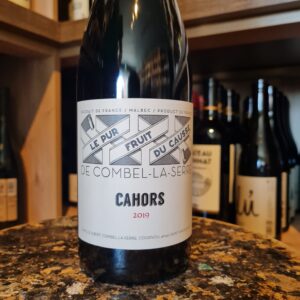 This lovely organic red is made from 100% Malbec (called Auxerrois in Cahors), ferments with indigenous yeasts, and ages in cement. This is a fruit-forward, easy-drinking style made for immediate consumption. And as soon as you pop a bottle, you'll see why "immediate" is the term they use. It's too tasty to wait, so enjoy it!
This lovely organic red is made from 100% Malbec (called Auxerrois in Cahors), ferments with indigenous yeasts, and ages in cement. This is a fruit-forward, easy-drinking style made for immediate consumption. And as soon as you pop a bottle, you'll see why "immediate" is the term they use. It's too tasty to wait, so enjoy it! -
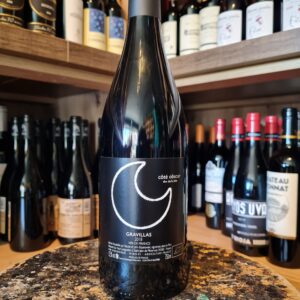 A typical blend of almost century-old Carignan and Cabernet Sauvignon. The vineyard is treated with respect, neither chemicals nor weed killers are tolerated, in order to preserve the biodiversity of the surrounding flora and fauna. The favourable terroir of white limestone pebbles, combined with low yields, gives mineral wines, with a beautiful freshness , and concentrated fruit. Manual harvest in 15 kg crates with severe sorting in the vineyard. 3 weeks pellicular maceration which brings a lot of fullness. We will find the aromatic complexity of Carignan with some notes of pepper and a tannic structure provided by the Cabernet. the tannins are nevertheless very fine. Pair this Coté Obscur wine with beef entrecote, duck skewer and some soft cheese. A real treat! Would recommend to decant this for at least an hour.
A typical blend of almost century-old Carignan and Cabernet Sauvignon. The vineyard is treated with respect, neither chemicals nor weed killers are tolerated, in order to preserve the biodiversity of the surrounding flora and fauna. The favourable terroir of white limestone pebbles, combined with low yields, gives mineral wines, with a beautiful freshness , and concentrated fruit. Manual harvest in 15 kg crates with severe sorting in the vineyard. 3 weeks pellicular maceration which brings a lot of fullness. We will find the aromatic complexity of Carignan with some notes of pepper and a tannic structure provided by the Cabernet. the tannins are nevertheless very fine. Pair this Coté Obscur wine with beef entrecote, duck skewer and some soft cheese. A real treat! Would recommend to decant this for at least an hour. -
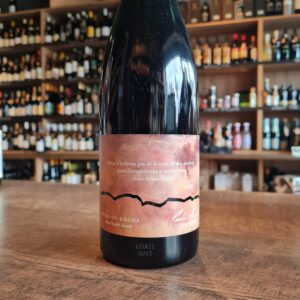 Vincent Rochette comes from a long line of grape growers rather than winemakers. In 1998, he bucked that trend by investing in a cellar and the necessary equipment to allow him to vinify his own grapes, which for five generations had been sold to other winemakers in the area. Vincent is an ardent believer in the benefits of biodynamics, fully converting his estate to follow that philosophy in 2006. He uses only natural products in the vineyard and carries out all his work in keeping with the cosmic cycles of the earth, not only among the vines but also in the cellar. One of his most interesting cuvées is the Côte du Rhone ‘Nature’, which has had no sulphites added at any stage of the winemaking process. Due to the fact that sulphites are naturally present in grapes, there are still 9mg present (below the legal 10mg limit which is required to state that the wine contains sulphites). The result is a wine that is simply a pure expression of Grenache and Syrah. Harvesting, racking and bottling are all carried out in accordance with cosmic rhythms. A delicious wine to consume today, with grills, summer salads, spicy dishes such as couscous, a tagine with candied fruits (apricots, lemons, onions, etc.)
Vincent Rochette comes from a long line of grape growers rather than winemakers. In 1998, he bucked that trend by investing in a cellar and the necessary equipment to allow him to vinify his own grapes, which for five generations had been sold to other winemakers in the area. Vincent is an ardent believer in the benefits of biodynamics, fully converting his estate to follow that philosophy in 2006. He uses only natural products in the vineyard and carries out all his work in keeping with the cosmic cycles of the earth, not only among the vines but also in the cellar. One of his most interesting cuvées is the Côte du Rhone ‘Nature’, which has had no sulphites added at any stage of the winemaking process. Due to the fact that sulphites are naturally present in grapes, there are still 9mg present (below the legal 10mg limit which is required to state that the wine contains sulphites). The result is a wine that is simply a pure expression of Grenache and Syrah. Harvesting, racking and bottling are all carried out in accordance with cosmic rhythms. A delicious wine to consume today, with grills, summer salads, spicy dishes such as couscous, a tagine with candied fruits (apricots, lemons, onions, etc.) -
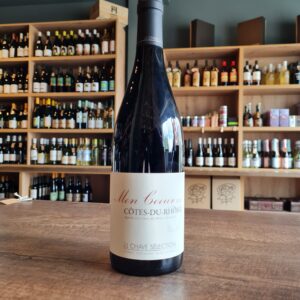 Domaine Jean-Louis Chave is one of the finest producers in the Northern Rhone. 16 generations of wine making has led to mastery of their art. This astonishing experience and expertise is pervasive in this wine. This deliciously ripe Syrah/Grenache blend has a wonderful core of dark, berry fruit supported by a framework of ripe tannin with cooling, granitic notes and a sleek, sophisticated texture. The sublime quality of the wines at this Domaine have meant that there has always been a long queue of Wine Merchants desperate for a glimpse of the Chave cellars. Gerard's son, Jean-Louis makes the wine at the Estate now and his ideal is to produce wine that is as pure an expression of the grape and terroir as possible. He achieves this by only vinifying the healthiest grapes produced from low yielding vines, intervening as little as possible while making the wine and bottling without filtration. His wines are some of the Rhône’s most complete and sophisticated examples. Jean Louis Chaves' selection wines are benchmarks of the Rhone, packed with regional character, that are made from a mixture of declassified Domaine fruit and grapes that are grown by Jean-Louis in conjunction with other vignobles. After tasting this gorgeous wine, I understood the name "Mon Coeur".
Domaine Jean-Louis Chave is one of the finest producers in the Northern Rhone. 16 generations of wine making has led to mastery of their art. This astonishing experience and expertise is pervasive in this wine. This deliciously ripe Syrah/Grenache blend has a wonderful core of dark, berry fruit supported by a framework of ripe tannin with cooling, granitic notes and a sleek, sophisticated texture. The sublime quality of the wines at this Domaine have meant that there has always been a long queue of Wine Merchants desperate for a glimpse of the Chave cellars. Gerard's son, Jean-Louis makes the wine at the Estate now and his ideal is to produce wine that is as pure an expression of the grape and terroir as possible. He achieves this by only vinifying the healthiest grapes produced from low yielding vines, intervening as little as possible while making the wine and bottling without filtration. His wines are some of the Rhône’s most complete and sophisticated examples. Jean Louis Chaves' selection wines are benchmarks of the Rhone, packed with regional character, that are made from a mixture of declassified Domaine fruit and grapes that are grown by Jean-Louis in conjunction with other vignobles. After tasting this gorgeous wine, I understood the name "Mon Coeur". -
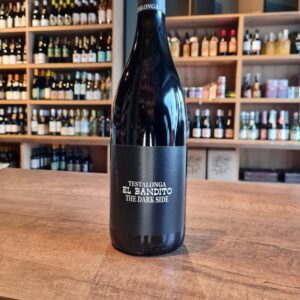 The El Bandito The Dark Side 2017 by Testalonga comes from Shiraz vineyards from the early 2000s - the vines are still in full bloom, but thanks to the low yield, they are already delivering phenolic grapes. The vineyards are cultivated by Craig with no herbicites, pesticides or fungicites. He also does without artificial irrigation. These measures alone have a positive effect on the quality of the grapes and keep the yield low. After hand-picking, the grapes are fermented spontaneously with the vineyard's own yeast and matured in 3000l wooden barrels. After expansion, it is neither fined nor filtered and filled with minimal sulfur. The Testalonga El Bandito The Dark Side has a deep dark color with a black core. It smells of red berries and dark stone fruits, of cloves, mocha and cocoa beans as well as tart spiciness. On the palate it has a present tannin and a fine interplay of acids. In terms of alcohol, the Shiraz is quite slim and straight, but still brings a weighty body into play. The finish is long and dominated by the heavier aromas. The El Bandito The Dark Side Shiraz demands air, so give it a few hours in the carafe before serving it slightly chilled from large glasses with roasted game, braised lamb or an oven-baked bean stew with roasted butter crumbs and thyme.
The El Bandito The Dark Side 2017 by Testalonga comes from Shiraz vineyards from the early 2000s - the vines are still in full bloom, but thanks to the low yield, they are already delivering phenolic grapes. The vineyards are cultivated by Craig with no herbicites, pesticides or fungicites. He also does without artificial irrigation. These measures alone have a positive effect on the quality of the grapes and keep the yield low. After hand-picking, the grapes are fermented spontaneously with the vineyard's own yeast and matured in 3000l wooden barrels. After expansion, it is neither fined nor filtered and filled with minimal sulfur. The Testalonga El Bandito The Dark Side has a deep dark color with a black core. It smells of red berries and dark stone fruits, of cloves, mocha and cocoa beans as well as tart spiciness. On the palate it has a present tannin and a fine interplay of acids. In terms of alcohol, the Shiraz is quite slim and straight, but still brings a weighty body into play. The finish is long and dominated by the heavier aromas. The El Bandito The Dark Side Shiraz demands air, so give it a few hours in the carafe before serving it slightly chilled from large glasses with roasted game, braised lamb or an oven-baked bean stew with roasted butter crumbs and thyme. -
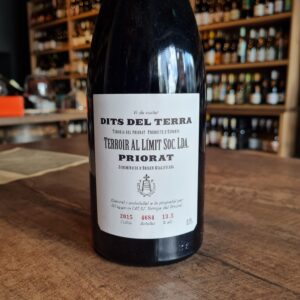 The wine Priorat Dits del Terra is a red wine produced in the Catalunya region, more precisely Priorat or the Torroja del Priorat in Spain, by Terroir al Limit. The vineyards are south facing in the sun-baked slate hills of Priorat and 60+ year old carignan vines are not usually harbingers of floral elegance and silken grace. And yet this gap between expectation and stunning creation is precisely what makes Dits de Terra so iconic. The vineyard, one of the original Terroir Al Limit holdings, honors the Cyprus trees that shade the historic Eremitas throughout the region. It is crafted using whole bunch fermentation and initial vinification in cement, then afforded a rare gift: time, in the form of 16 months in Stockinger foudres and cement, with a gentle and unobtrusive elevage. This care and attention elevates it into a fine, complex and fluid expression of different terroirs. The dark depths in the glass belie its ephemeral lightness in aroma and flavor. Breathy black fruits and a persistent herbality enhance the supple spice and suspended movement across the palate. Anise, fresh fennel and rose notes are underscored with a fluid web of balsamic accents - never weighty nor wide. The wine exudes gravitas with the elegant confidence that comes only from complete comfort in one’s own skin. Only 2000 bottles produced, Masterclass of a wine!
The wine Priorat Dits del Terra is a red wine produced in the Catalunya region, more precisely Priorat or the Torroja del Priorat in Spain, by Terroir al Limit. The vineyards are south facing in the sun-baked slate hills of Priorat and 60+ year old carignan vines are not usually harbingers of floral elegance and silken grace. And yet this gap between expectation and stunning creation is precisely what makes Dits de Terra so iconic. The vineyard, one of the original Terroir Al Limit holdings, honors the Cyprus trees that shade the historic Eremitas throughout the region. It is crafted using whole bunch fermentation and initial vinification in cement, then afforded a rare gift: time, in the form of 16 months in Stockinger foudres and cement, with a gentle and unobtrusive elevage. This care and attention elevates it into a fine, complex and fluid expression of different terroirs. The dark depths in the glass belie its ephemeral lightness in aroma and flavor. Breathy black fruits and a persistent herbality enhance the supple spice and suspended movement across the palate. Anise, fresh fennel and rose notes are underscored with a fluid web of balsamic accents - never weighty nor wide. The wine exudes gravitas with the elegant confidence that comes only from complete comfort in one’s own skin. Only 2000 bottles produced, Masterclass of a wine! -
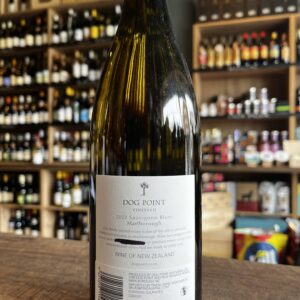
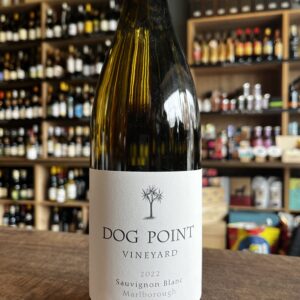 Dog Point Vineyard is New Zealand's largest certified organic vineyard by Biogro NZ. We are family owned and one of the oldest privately established vineyards, located on the hill slopes of the Southern Valleys of Marlborough, New Zealand. Marlborough is blessed with one of the sunniest and driest climates in New Zealand. The significant diurnal temperature range between cool nights and sunny days allows ideal conditions for the long slow ripening of grapes. Soils are crucial to the character of our wine. Most soils have been laid down within the last 14,000 years carved and eroded by glaciers in the high country and carried down to the coast by melt-water rivers. Older well-established vines are situated on free draining silty clay loams. This is supplemented with more recent plantings on closely planted hillside blocks on soils with a clay loam influence. Pair with fresh, simple seafood dishes especially oysters. Also compliments goat's cheese well
Dog Point Vineyard is New Zealand's largest certified organic vineyard by Biogro NZ. We are family owned and one of the oldest privately established vineyards, located on the hill slopes of the Southern Valleys of Marlborough, New Zealand. Marlborough is blessed with one of the sunniest and driest climates in New Zealand. The significant diurnal temperature range between cool nights and sunny days allows ideal conditions for the long slow ripening of grapes. Soils are crucial to the character of our wine. Most soils have been laid down within the last 14,000 years carved and eroded by glaciers in the high country and carried down to the coast by melt-water rivers. Older well-established vines are situated on free draining silty clay loams. This is supplemented with more recent plantings on closely planted hillside blocks on soils with a clay loam influence. Pair with fresh, simple seafood dishes especially oysters. Also compliments goat's cheese well -
Out of stock
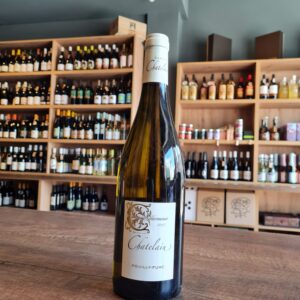 The Chatelain family has worked the vineyards of Pouilly-sur-Loire since the 1630s. Today the family farm is run by Jean-Claude and Geneviève Chatelain, the 11th generation of winemakers from Domaine Chatelain. The grapes for Les Chailloux are grown on the St. Andelain Hill with its clay and siliceous soils strewn with pebbles and flint; the wine is aged ‘sur lie’ prior to bottling in the spring. Light yellow-gold; the wine is vivid, aromatic and minerally on the nose, followed by a spicy flint (silex) character on the palate.
The Chatelain family has worked the vineyards of Pouilly-sur-Loire since the 1630s. Today the family farm is run by Jean-Claude and Geneviève Chatelain, the 11th generation of winemakers from Domaine Chatelain. The grapes for Les Chailloux are grown on the St. Andelain Hill with its clay and siliceous soils strewn with pebbles and flint; the wine is aged ‘sur lie’ prior to bottling in the spring. Light yellow-gold; the wine is vivid, aromatic and minerally on the nose, followed by a spicy flint (silex) character on the palate. -
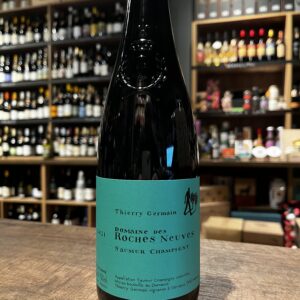 The 50-hectare Domaine des Roches Neuves is run by Bordelais Thierry Germain who originally was from Bordeaux and is situated in the appellation of Saumur-Champigny. The winery has existed since 1850, and since purchasing the estate in 1991, Thierry run it with such incredible will and tenacity that turned Domaine des Roches Neuves into one of the finest wineries/farms in France. Not to forget it wasn't without the help of his mentor and spiritual father Charly Foucault of Clos Rougeard The estate is run strictly along biodynamic lines, harvesting is manual and yields are low. This stunning wine pairs well with pork rillettes, lamb shank confit, grilled artichokes. Try it with just cheeses and charcuterie
The 50-hectare Domaine des Roches Neuves is run by Bordelais Thierry Germain who originally was from Bordeaux and is situated in the appellation of Saumur-Champigny. The winery has existed since 1850, and since purchasing the estate in 1991, Thierry run it with such incredible will and tenacity that turned Domaine des Roches Neuves into one of the finest wineries/farms in France. Not to forget it wasn't without the help of his mentor and spiritual father Charly Foucault of Clos Rougeard The estate is run strictly along biodynamic lines, harvesting is manual and yields are low. This stunning wine pairs well with pork rillettes, lamb shank confit, grilled artichokes. Try it with just cheeses and charcuterie -
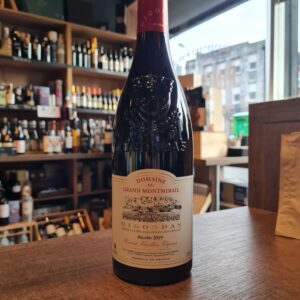 Domaine du Grand Montmirail Gigondas lies in the foothills of a limestone escarpment in a remote part of Gigondas. A blend of Grenache, Syrah and Mourvedre, this wine has real depth of flavour with concentrated black fruits balanced by fresh acidity and a rich warm finish. In Gigondas, cultivating grapes to make wine and olives to make oil stretches back to ancient times. As long ago as the 1st century, Julius Caesar established a colony of veterans on this site. One is said to have been so jovial that he was nicknamed Jucundus, 'the joyful', and his village became known as Jocundatis, which later became Gigondas. Domain du Grand Montmirail covers more than 35 Ha, planted exclusively on the hillsides and terraces located south / south-east side of the Dentelles de Montmirail, forming a superb amphitheater dedicated to the vine and the wine. The altitude of the vineyard varies between 300 and 350 meters and enjoys natural protection against the wind dominating the mistral. The vineyard is composed of Grenache, Syrah and Mourvèdre parcels, aged between 15 and 65 years. The harvest begins with Syrah, the quickest grape to ripen, and then the Grenache in the highest spots. The Mourvèdre is the slowest ripening and usually the last grape to be harvested. The entire harvest is picked by hand, and yields are never more than 35 hl/ha. Among the old vines on the terraces, they generally fall to a maximum of 30 hl/ha. The recently picked grapes are transported quickly to the winery situated off to the side of the vineyards. Pair it with Beef, Casserole, Lamb, Mushrooms
Domaine du Grand Montmirail Gigondas lies in the foothills of a limestone escarpment in a remote part of Gigondas. A blend of Grenache, Syrah and Mourvedre, this wine has real depth of flavour with concentrated black fruits balanced by fresh acidity and a rich warm finish. In Gigondas, cultivating grapes to make wine and olives to make oil stretches back to ancient times. As long ago as the 1st century, Julius Caesar established a colony of veterans on this site. One is said to have been so jovial that he was nicknamed Jucundus, 'the joyful', and his village became known as Jocundatis, which later became Gigondas. Domain du Grand Montmirail covers more than 35 Ha, planted exclusively on the hillsides and terraces located south / south-east side of the Dentelles de Montmirail, forming a superb amphitheater dedicated to the vine and the wine. The altitude of the vineyard varies between 300 and 350 meters and enjoys natural protection against the wind dominating the mistral. The vineyard is composed of Grenache, Syrah and Mourvèdre parcels, aged between 15 and 65 years. The harvest begins with Syrah, the quickest grape to ripen, and then the Grenache in the highest spots. The Mourvèdre is the slowest ripening and usually the last grape to be harvested. The entire harvest is picked by hand, and yields are never more than 35 hl/ha. Among the old vines on the terraces, they generally fall to a maximum of 30 hl/ha. The recently picked grapes are transported quickly to the winery situated off to the side of the vineyards. Pair it with Beef, Casserole, Lamb, Mushrooms -
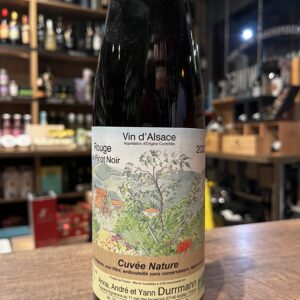 This wine is imported exclusively for Pinto Wines. The Durrmann estate is located in the municipality of Andlau, in Alsace, an ancient medieval village in which vines have been cultivated for more than a thousand years. The winery was created in 1979 with some vineyards owned by Yann's grandfather, who was a shoemaker. The lack of experience in the wine sector was a disadvantage as they had to start from scratch, but also a big advantage as they were able to immediately differentiate themselves from tradition and move towards the most natural agriculture possible with a push "of thought "very innovative. As André expanded the domain into what it is today and managed to collect a beautiful vineyard property (more than 8 hectares now), he been working completely organically since 1998, but he also applies permaculture principles to achieve the greatest possible biodiversity in the vineyards. For example, he planted trees among the grapes. He does not plow the vineyards, because he thinks that would disrupt soil life. At most he mows the grass. In winter he lets his own small flock of sheep graze the vineyards. To keep it within the vineyard, he has fenced off all his plots with mesh and fences; This also helps to keep wild boars - which appear to have a great preference for organic vineyards! - at bay. André cruises through the village in an electric car, powered by electricity he produces himself (because he refuses to use electricity from a nuclear power plant). His wife Anna cooks vegetables and potatoes on two large dishes in the courtyard that catch the sunlight and heat the pans. Anyway, you get the picture. Son Yann has now taken over the domain and more and more cuvées are now made completely naturally. Not filtered, and without added sulfite. They also still make some cuvées with sulphite, because they do not want to alienate the large private customer base that buys at the door. But most customers respond positively, so they will steadily expand the nature range. Even Rieslings from Grand Cru vineyards are now being marketed as natural wine. Taste this next to the sulfited version and you will notice that the terroir in the natural version comes out even better! Perfect at room temperature in the winter, slightly chill it in the summer. Serve with white meat or light nibbles or on its own!!Delicious and to come back for more
This wine is imported exclusively for Pinto Wines. The Durrmann estate is located in the municipality of Andlau, in Alsace, an ancient medieval village in which vines have been cultivated for more than a thousand years. The winery was created in 1979 with some vineyards owned by Yann's grandfather, who was a shoemaker. The lack of experience in the wine sector was a disadvantage as they had to start from scratch, but also a big advantage as they were able to immediately differentiate themselves from tradition and move towards the most natural agriculture possible with a push "of thought "very innovative. As André expanded the domain into what it is today and managed to collect a beautiful vineyard property (more than 8 hectares now), he been working completely organically since 1998, but he also applies permaculture principles to achieve the greatest possible biodiversity in the vineyards. For example, he planted trees among the grapes. He does not plow the vineyards, because he thinks that would disrupt soil life. At most he mows the grass. In winter he lets his own small flock of sheep graze the vineyards. To keep it within the vineyard, he has fenced off all his plots with mesh and fences; This also helps to keep wild boars - which appear to have a great preference for organic vineyards! - at bay. André cruises through the village in an electric car, powered by electricity he produces himself (because he refuses to use electricity from a nuclear power plant). His wife Anna cooks vegetables and potatoes on two large dishes in the courtyard that catch the sunlight and heat the pans. Anyway, you get the picture. Son Yann has now taken over the domain and more and more cuvées are now made completely naturally. Not filtered, and without added sulfite. They also still make some cuvées with sulphite, because they do not want to alienate the large private customer base that buys at the door. But most customers respond positively, so they will steadily expand the nature range. Even Rieslings from Grand Cru vineyards are now being marketed as natural wine. Taste this next to the sulfited version and you will notice that the terroir in the natural version comes out even better! Perfect at room temperature in the winter, slightly chill it in the summer. Serve with white meat or light nibbles or on its own!!Delicious and to come back for more -
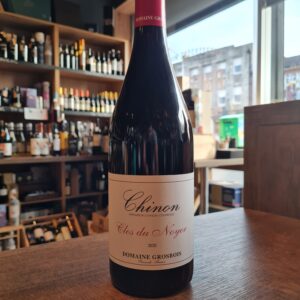 Located on the right bank of the Vienne Valley, between Tours and Saumur, Domaine Grosbois is an old fortified farm built in the 15th century which today covers 20 hectares of vines. Now run by two brothers, Nicolas and Sylvain, the family vineyards are located at a place called “The Pressoir” Panzoult in the Chinon appellation at the heart of the Loire Valley. The winemaking here is concentrated solely on the production of red wines made from the Cabernet Franc grape. Nicolas has been at the domaine since 2005 after returning from ten years working as a travelling winemaker, gaining experience in locations as diverse as the Minervois, Chile, Oregon (Adelsheim), Australia (Brokenwood) and New Zealand (Pegasus Bay). His first vintage was in 2006 where he worked alongside his father, Jacques (who had previously been more inclined to sell off the production in cubitainer). Jacques retired, or at least withdrew, in 2008 allowing Nicolas to develop the domaine in the way he intended to continue, converting to organic and biodynamic viticulture. The winemaking philosophy at Grosbois is centred around the idea of micro-site specificity with the various Cabernet Franc bottling's reflecting the 19 unique plots of vines on the Panzoult Hill, all of which had been strategically planted according to their geological characteristics. Once in the cellar, Nicolas lets the grapes speak for themselves, keeping a light hand at winemaking. He ferments in open concrete tanks with indigenous yeast, uses no oak and minimal filtration, so what you find in the final wine is a pure expression of a teeny parcel of Chinon. Pair it with roast duck with peppers. Serve after slight aeration
Located on the right bank of the Vienne Valley, between Tours and Saumur, Domaine Grosbois is an old fortified farm built in the 15th century which today covers 20 hectares of vines. Now run by two brothers, Nicolas and Sylvain, the family vineyards are located at a place called “The Pressoir” Panzoult in the Chinon appellation at the heart of the Loire Valley. The winemaking here is concentrated solely on the production of red wines made from the Cabernet Franc grape. Nicolas has been at the domaine since 2005 after returning from ten years working as a travelling winemaker, gaining experience in locations as diverse as the Minervois, Chile, Oregon (Adelsheim), Australia (Brokenwood) and New Zealand (Pegasus Bay). His first vintage was in 2006 where he worked alongside his father, Jacques (who had previously been more inclined to sell off the production in cubitainer). Jacques retired, or at least withdrew, in 2008 allowing Nicolas to develop the domaine in the way he intended to continue, converting to organic and biodynamic viticulture. The winemaking philosophy at Grosbois is centred around the idea of micro-site specificity with the various Cabernet Franc bottling's reflecting the 19 unique plots of vines on the Panzoult Hill, all of which had been strategically planted according to their geological characteristics. Once in the cellar, Nicolas lets the grapes speak for themselves, keeping a light hand at winemaking. He ferments in open concrete tanks with indigenous yeast, uses no oak and minimal filtration, so what you find in the final wine is a pure expression of a teeny parcel of Chinon. Pair it with roast duck with peppers. Serve after slight aeration -
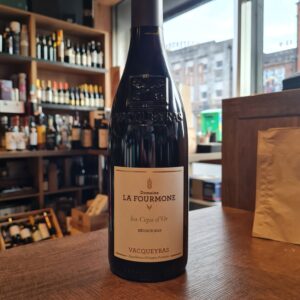 Domaine la Fourmone is a multi-generational domaine and is currently run by sister, Florentine and brother, Albin Combe. The property dates back to the mid-1700’s when it originally producing wheat. Wine began to be grown in the last 19th century and thent became the crop after Julien Combe purchased the property in 1910. The domaine cultivates 41 ha (104 acres) of vineyards of which, 20ha are in Vacqueyras, 10ha are in Gigondas and 7ha of Côtes-du-Rhône and IGP and 4ha of vines on the southern edge of the Dentelles hills that reside in the Ventoux appellation. “Les Ceps d’Or” comes from a blend of mainly Grenache and Mourvèdre. It expresses the imprint of the 50 years of our goblet-pruned vines. The berries are delicately harvested on the northern and eastern limits of the Vacqueyras appellation. The plots come from two islands located on the plateau of the appellation at the foothills of the Dentelles de Montmirail, a massif well known for its geological richness. The first islet is located in the Piedmont de Beauregard region. The soil is made up of dark beige marly silts, cut by broken slabs of Miocene molasses at a depth of one meter. This terroir requires a lot of effort from the vines to slide their rootlets into the cracks and deploy meters of roots. This effort gives the wine a singular complexity and aromatic richness. The second islet is located at the northern limit of the Cône de la Font des Papes terroir. A surface of light beige clay-sandy silt with small limestone fragments with a well-developed root profile up to two meters deep. The materials from this terroir have all the criteria favorable to the vine: freshness and good water reserve.
Domaine la Fourmone is a multi-generational domaine and is currently run by sister, Florentine and brother, Albin Combe. The property dates back to the mid-1700’s when it originally producing wheat. Wine began to be grown in the last 19th century and thent became the crop after Julien Combe purchased the property in 1910. The domaine cultivates 41 ha (104 acres) of vineyards of which, 20ha are in Vacqueyras, 10ha are in Gigondas and 7ha of Côtes-du-Rhône and IGP and 4ha of vines on the southern edge of the Dentelles hills that reside in the Ventoux appellation. “Les Ceps d’Or” comes from a blend of mainly Grenache and Mourvèdre. It expresses the imprint of the 50 years of our goblet-pruned vines. The berries are delicately harvested on the northern and eastern limits of the Vacqueyras appellation. The plots come from two islands located on the plateau of the appellation at the foothills of the Dentelles de Montmirail, a massif well known for its geological richness. The first islet is located in the Piedmont de Beauregard region. The soil is made up of dark beige marly silts, cut by broken slabs of Miocene molasses at a depth of one meter. This terroir requires a lot of effort from the vines to slide their rootlets into the cracks and deploy meters of roots. This effort gives the wine a singular complexity and aromatic richness. The second islet is located at the northern limit of the Cône de la Font des Papes terroir. A surface of light beige clay-sandy silt with small limestone fragments with a well-developed root profile up to two meters deep. The materials from this terroir have all the criteria favorable to the vine: freshness and good water reserve. -
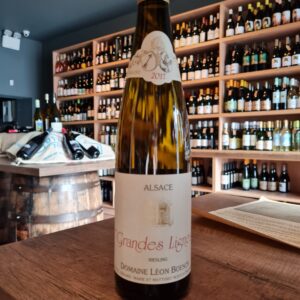 The Boesch domaine is located within the Vallèe Noble, in the “Ballons des Vosges” natural park. A magical place, surrounded by splendid vineyards at the foot of the two highest mountains of the Vosges range. The Boesch family has lived there and worked the land since 1640. 25 year old biodynamic vines planted in a limestone and sandstone-clay soil on an east facing hillside give this delicious wine. This wine is the subject of evident care: ploughing, natural treatments, and the vines are fertilized with compost produced on the estate. The harvest, the highlight of the year, is carried out exclusively by hand, and fermentation takes place with indigenous yeasts in oak casks. The nose is characterized by rhubarb, apricot, anise and gingerbread. On the palate it is very clean. Definitely a great Riesling.
The Boesch domaine is located within the Vallèe Noble, in the “Ballons des Vosges” natural park. A magical place, surrounded by splendid vineyards at the foot of the two highest mountains of the Vosges range. The Boesch family has lived there and worked the land since 1640. 25 year old biodynamic vines planted in a limestone and sandstone-clay soil on an east facing hillside give this delicious wine. This wine is the subject of evident care: ploughing, natural treatments, and the vines are fertilized with compost produced on the estate. The harvest, the highlight of the year, is carried out exclusively by hand, and fermentation takes place with indigenous yeasts in oak casks. The nose is characterized by rhubarb, apricot, anise and gingerbread. On the palate it is very clean. Definitely a great Riesling. -
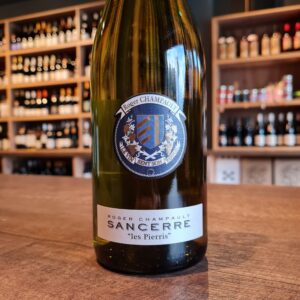 Five generations of traditional winemaking from the estate of Roger Champault, modern thermoregulation techniques, and carefully chosen soil matching, have produced a Cuvee that is subtle at first, like the rising of a summer breeze, building in its complexity with wispy herbal notes and abundant florals that dance across the taste buds like wind through an apple orchard. Delicate, yet so very alive. This wine drinks with a lovely, masterfully structured liveliness and sweet, concentrated finish.Thanks to its abundant fruitiness, it is suitable not only for seafood and crabs but also for more abundant fish dishes; fried salmon, pike perch etc. Also suitable for light meat, especially poultry dishes.Curious note, Sancerre Les Pierris 2008 wine was served at the wedding dinner of Princess Victoria and Daniel of Sweden.
Five generations of traditional winemaking from the estate of Roger Champault, modern thermoregulation techniques, and carefully chosen soil matching, have produced a Cuvee that is subtle at first, like the rising of a summer breeze, building in its complexity with wispy herbal notes and abundant florals that dance across the taste buds like wind through an apple orchard. Delicate, yet so very alive. This wine drinks with a lovely, masterfully structured liveliness and sweet, concentrated finish.Thanks to its abundant fruitiness, it is suitable not only for seafood and crabs but also for more abundant fish dishes; fried salmon, pike perch etc. Also suitable for light meat, especially poultry dishes.Curious note, Sancerre Les Pierris 2008 wine was served at the wedding dinner of Princess Victoria and Daniel of Sweden. -
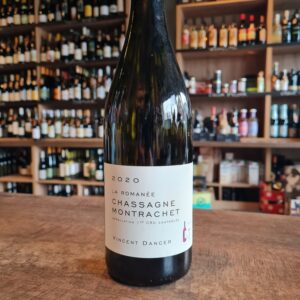 Vincent Dancer grew up in Alsace, where he inherited a love of wine and photography from his father. After studying engineering, his father suggested that Vincent spend some time in Burgundy, where his family owned some vines that were being rented out to cousins. Dancer was immediately hooked, and decided to settle in Chassagne-Montrachet and make wine from the five hectares of well-situated vineyards. The winery is small even by the standards of Burgundy, and despite Dancer’s reclusive nature, the wines are well known to a small circle of restaurateurs and wine-lovers who reliably take their miniscule allocation year after year. Dancer was the first producer in Chassagne to become certified organic, and there remains less than a handful of others. He is quietly individualistic, creating his own lean, bright, and savory style of wines, trusting his instincts and experience to make the best possible wine in his own way. Each cuvée, however, is truly a reflection of the terroir—from the rich, unctuous Meursault Perrières to the incisively fresh Chassagne Tête du Clos. It is not an exaggeration to say that the wines from Vincent Dancer are majestically unique, exceptionally delicious, and well worth the effort of seeking out.
Vincent Dancer grew up in Alsace, where he inherited a love of wine and photography from his father. After studying engineering, his father suggested that Vincent spend some time in Burgundy, where his family owned some vines that were being rented out to cousins. Dancer was immediately hooked, and decided to settle in Chassagne-Montrachet and make wine from the five hectares of well-situated vineyards. The winery is small even by the standards of Burgundy, and despite Dancer’s reclusive nature, the wines are well known to a small circle of restaurateurs and wine-lovers who reliably take their miniscule allocation year after year. Dancer was the first producer in Chassagne to become certified organic, and there remains less than a handful of others. He is quietly individualistic, creating his own lean, bright, and savory style of wines, trusting his instincts and experience to make the best possible wine in his own way. Each cuvée, however, is truly a reflection of the terroir—from the rich, unctuous Meursault Perrières to the incisively fresh Chassagne Tête du Clos. It is not an exaggeration to say that the wines from Vincent Dancer are majestically unique, exceptionally delicious, and well worth the effort of seeking out. -
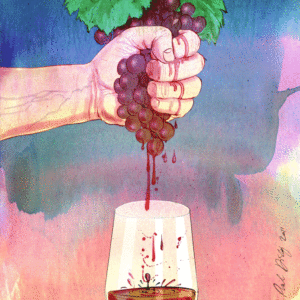 More and more wine producers are adopting organic winemaking as the way forward, and they are stunning wines out there. There are many reasons why people enjoy organic wines. For some, it became a way of life, for others it just “feels right”. The old fear ''I don't trust organic wines'' or ''They all taste the same'' is disappearing, with more people converting to organic wines as there is more knowledge, greater quality and a heavily regulated market that will certify these wines. We brought you a case for any occasion with easy drinking 6 bottles. They say natural wine can be tricky to understand, well no expertise needed with these wines. An essential mix of light, low sulphite, crisp fresh white and a soft, pleasurable red. All organic, all vegan, all tasty. No need to drown in the complexity of natural wine, just try these and enjoy. Bardos Rueda Verdejo - This artisan verdejo is part of the reason the Spanish Rueda region has become quite popular. Made unapologetically, you will find yourself like a true “Bard” drinking this wine. Delicious! Sepp Gruner Veltliner - All Sepp Moser wines have been organic (and all estate wines biodynamic) since 2007. Delicate aromas of pear, kiwi, apricot and white spice. On the palate stone fruit flavours and white pepper lead to a gently textured, mineral and citrus finish. Combel La Serre L'Epatant Antidote Rosé - 100% French Malbec (known in Cahors as Auxerrois). The vines are 40 years old, grown on clay and limestone soils. Fermentation and aging take place in small tanks."The Splendid Antidote to the Heat of the Causse" is the amusing and appropriate name of this refreshing rosé. (The Causse is the high limestone plateau around Cahors, which gets brutally hot in the summer.) The wine shows a pretty pink/orange color and aromas of ripe cherry, raspberry and cassis with citrus and spice. It precedes a palate that is both fleshy, suave and savory, with formidable gluttony. Both easy and winey, it's an absolute delight! Roche-Audran, ‘Nature’ Còtes-du-Rhône - Vincent Rochette comes from a long line of grape growers rather than winemakers up until 1998 when he bucked that trend by investing in a cellar and the necessary equipment to allow him to vinify his own grapes . He uses only natural products in the vineyard and carries out all his work in keeping with the cosmic cycles of the earth, not only among the vines but also in the cellar. One of his most interesting cuvées is the Côte du Rhone ‘Nature’, which has had no sulphites added at any stage of the winemaking process. Due to the fact that sulphites are naturally present in grapes, there are still 9mg present (below the legal 10mg limit which is required to state that the wine contains sulphites), an insignificant figure compared to the conventional levels found in most wines. The result is a wine that is simply a pure expression of Grenache, Carignan, Syrah and Mourvèdre. Harvesting, racking and bottling are all carried out in accordance with cosmic rhythms. Pitti Pittnauer Red - High on the hills of Austria there is more than just a lonely goat herd – there is also a fantastic winery, considered one of the country’s best. Pittnauer has a long winemaking tradition in the region, and in 2006 moved to more biodynamic practices. The results are delicious, environmentally friendly wines with years of experience behind them. Now prepare yourself for some varieties you’ve probably never heard of – Pittnauer’s Pitti Red Blend is made from blaufränkisch and Zweigelt grapes with a small quantity of Merlot added to the mixture. Filipa Pato Dinâmica Baga 2019 - Filipa Pato is the confirmation of the old saying "son of fish knows how to swim". Although she followed the footsteps of her father Luís Pato, Filipa went on her own and started a project in 2001. The success was immediate, and soon she rose to the status of one of the most brilliant winemakers in Portugal. Her wines are the result of Filipa's innovative and brilliant spirit. They were quickly at the forefront of national and international criticism. Dinâmica Baga is a wine that, due to its proximity to the sea, presents an intense, complex and elegant aroma with a touch of fruit such as strawberry and plum, nuances of liquorice and notes of spices such as black pepper, bay leaves and thyme, and balanced acidity. In the mouth it is fruity, with a beautiful structure and velvety texture, with a very fresh and inviting finish.
More and more wine producers are adopting organic winemaking as the way forward, and they are stunning wines out there. There are many reasons why people enjoy organic wines. For some, it became a way of life, for others it just “feels right”. The old fear ''I don't trust organic wines'' or ''They all taste the same'' is disappearing, with more people converting to organic wines as there is more knowledge, greater quality and a heavily regulated market that will certify these wines. We brought you a case for any occasion with easy drinking 6 bottles. They say natural wine can be tricky to understand, well no expertise needed with these wines. An essential mix of light, low sulphite, crisp fresh white and a soft, pleasurable red. All organic, all vegan, all tasty. No need to drown in the complexity of natural wine, just try these and enjoy. Bardos Rueda Verdejo - This artisan verdejo is part of the reason the Spanish Rueda region has become quite popular. Made unapologetically, you will find yourself like a true “Bard” drinking this wine. Delicious! Sepp Gruner Veltliner - All Sepp Moser wines have been organic (and all estate wines biodynamic) since 2007. Delicate aromas of pear, kiwi, apricot and white spice. On the palate stone fruit flavours and white pepper lead to a gently textured, mineral and citrus finish. Combel La Serre L'Epatant Antidote Rosé - 100% French Malbec (known in Cahors as Auxerrois). The vines are 40 years old, grown on clay and limestone soils. Fermentation and aging take place in small tanks."The Splendid Antidote to the Heat of the Causse" is the amusing and appropriate name of this refreshing rosé. (The Causse is the high limestone plateau around Cahors, which gets brutally hot in the summer.) The wine shows a pretty pink/orange color and aromas of ripe cherry, raspberry and cassis with citrus and spice. It precedes a palate that is both fleshy, suave and savory, with formidable gluttony. Both easy and winey, it's an absolute delight! Roche-Audran, ‘Nature’ Còtes-du-Rhône - Vincent Rochette comes from a long line of grape growers rather than winemakers up until 1998 when he bucked that trend by investing in a cellar and the necessary equipment to allow him to vinify his own grapes . He uses only natural products in the vineyard and carries out all his work in keeping with the cosmic cycles of the earth, not only among the vines but also in the cellar. One of his most interesting cuvées is the Côte du Rhone ‘Nature’, which has had no sulphites added at any stage of the winemaking process. Due to the fact that sulphites are naturally present in grapes, there are still 9mg present (below the legal 10mg limit which is required to state that the wine contains sulphites), an insignificant figure compared to the conventional levels found in most wines. The result is a wine that is simply a pure expression of Grenache, Carignan, Syrah and Mourvèdre. Harvesting, racking and bottling are all carried out in accordance with cosmic rhythms. Pitti Pittnauer Red - High on the hills of Austria there is more than just a lonely goat herd – there is also a fantastic winery, considered one of the country’s best. Pittnauer has a long winemaking tradition in the region, and in 2006 moved to more biodynamic practices. The results are delicious, environmentally friendly wines with years of experience behind them. Now prepare yourself for some varieties you’ve probably never heard of – Pittnauer’s Pitti Red Blend is made from blaufränkisch and Zweigelt grapes with a small quantity of Merlot added to the mixture. Filipa Pato Dinâmica Baga 2019 - Filipa Pato is the confirmation of the old saying "son of fish knows how to swim". Although she followed the footsteps of her father Luís Pato, Filipa went on her own and started a project in 2001. The success was immediate, and soon she rose to the status of one of the most brilliant winemakers in Portugal. Her wines are the result of Filipa's innovative and brilliant spirit. They were quickly at the forefront of national and international criticism. Dinâmica Baga is a wine that, due to its proximity to the sea, presents an intense, complex and elegant aroma with a touch of fruit such as strawberry and plum, nuances of liquorice and notes of spices such as black pepper, bay leaves and thyme, and balanced acidity. In the mouth it is fruity, with a beautiful structure and velvety texture, with a very fresh and inviting finish. -
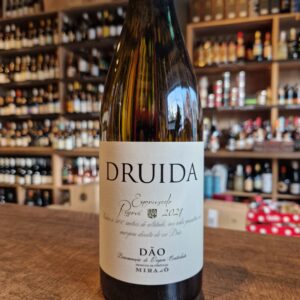 Mira do O produces expressive, concentrated wines. Despite the concentration, all the wines are fresh, elegant, well-balanced and shows great maturation potential. Dao region is valued by wine lovers for its expressiveness, freshness, concentration of taste and longevity of the wine. The region is a little further away from the Atlantic Ocean, but its cold winds still cool Dao vineyards. For this reason, the wine is high levels of acidity and great balance. The poor granite soil prevalent in the region gives the wines more texture, depth and spice. It is worth mentioning that here is a register and a large part of the old, local Portuguese grapes. Mira do O Druida Encruzado Reserva is made from a small vineyard located on a 500-meter plateau. This plateau provides protection from excess Atlantic moisture. At the same time, the temperature fluctuations caused by this altitude allow the grapes to ripen perfectly during the day, but they are more refreshing due to the cooling vineyards. The winemaker follows the principle of minimalist intervention: to change the wine as little as possible during its production. For this reason, the very characteristics of the grape stand out. Pair it with aperitif, roast white meats, sautee greens
Mira do O produces expressive, concentrated wines. Despite the concentration, all the wines are fresh, elegant, well-balanced and shows great maturation potential. Dao region is valued by wine lovers for its expressiveness, freshness, concentration of taste and longevity of the wine. The region is a little further away from the Atlantic Ocean, but its cold winds still cool Dao vineyards. For this reason, the wine is high levels of acidity and great balance. The poor granite soil prevalent in the region gives the wines more texture, depth and spice. It is worth mentioning that here is a register and a large part of the old, local Portuguese grapes. Mira do O Druida Encruzado Reserva is made from a small vineyard located on a 500-meter plateau. This plateau provides protection from excess Atlantic moisture. At the same time, the temperature fluctuations caused by this altitude allow the grapes to ripen perfectly during the day, but they are more refreshing due to the cooling vineyards. The winemaker follows the principle of minimalist intervention: to change the wine as little as possible during its production. For this reason, the very characteristics of the grape stand out. Pair it with aperitif, roast white meats, sautee greens -
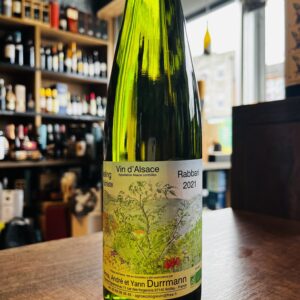 This wine is imported directly and only for Pinto Wines Riesling on Schist makes its terroir apparent with a livewire acidity and snap, rocky, chalky and mineral. Low yielding parcels. Long and driving, a little structure from 2022. The Durrmann family are making wine from their old family house in the middle of Andlau, a beautiful village nestled on the first slopes of the Vosges mountains south-west of Strasbourg. With a surface of only 1,5 hectare at the beginning in 1979, the domaine gradually reached a total surface of seven hectares after André decided to move back to farming and pieced it together from abandoned vineyard sites that were hard to work and no longer commercially viable, coming from his grandfather who made shoes to supplement the farm income. This lack of an established and family-based wine making tradition initially presented a weakness because the whole business had to be built, but it is also a strength because the company wasn’t limited to traditional customs, and therefore has always been oriented toward innovation. The vineyards are now scattered on about 30 spots around the village. They added parcels progressively when opportunities showed up and looked also for different soil qualities so that the cuvées express several terroirs. The Durrmans think that the quality of the wine is created by the work in the vineyard, that’s why their objective is its preservation. The wines are being disturbed as little as possible. They do not add any oenological product to change the natural taste of the wines. The production is partly vinified in inox tank and partly in old wooden casks. Son Yann has worked in the domaine since he was a child and officially took over the running of the business a year ago. André was among the first wave of organic winemakers in Alsace converting in 1998, Yann has then taken this a step further applying a more natural approach in the cellar. Selected cuvées are produced without sulfur addition since 2007. The Durrmanns are true eco warriors only having electric cars and using solar energy for hot water and heating. Pair it with Pork, Seafood, Curries, Spicy dishes
This wine is imported directly and only for Pinto Wines Riesling on Schist makes its terroir apparent with a livewire acidity and snap, rocky, chalky and mineral. Low yielding parcels. Long and driving, a little structure from 2022. The Durrmann family are making wine from their old family house in the middle of Andlau, a beautiful village nestled on the first slopes of the Vosges mountains south-west of Strasbourg. With a surface of only 1,5 hectare at the beginning in 1979, the domaine gradually reached a total surface of seven hectares after André decided to move back to farming and pieced it together from abandoned vineyard sites that were hard to work and no longer commercially viable, coming from his grandfather who made shoes to supplement the farm income. This lack of an established and family-based wine making tradition initially presented a weakness because the whole business had to be built, but it is also a strength because the company wasn’t limited to traditional customs, and therefore has always been oriented toward innovation. The vineyards are now scattered on about 30 spots around the village. They added parcels progressively when opportunities showed up and looked also for different soil qualities so that the cuvées express several terroirs. The Durrmans think that the quality of the wine is created by the work in the vineyard, that’s why their objective is its preservation. The wines are being disturbed as little as possible. They do not add any oenological product to change the natural taste of the wines. The production is partly vinified in inox tank and partly in old wooden casks. Son Yann has worked in the domaine since he was a child and officially took over the running of the business a year ago. André was among the first wave of organic winemakers in Alsace converting in 1998, Yann has then taken this a step further applying a more natural approach in the cellar. Selected cuvées are produced without sulfur addition since 2007. The Durrmanns are true eco warriors only having electric cars and using solar energy for hot water and heating. Pair it with Pork, Seafood, Curries, Spicy dishes -
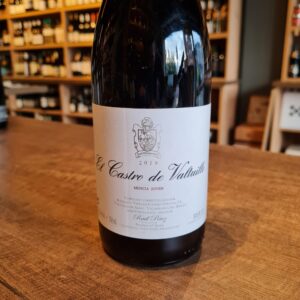 The Castro Ventosa estate was founded by the Perez family in 1752 and has been in the family ever since. They own 75 hectares of Mencía vines in Bierzo, making them the biggest owners of this varietal within the D.O Bierzo. For this wine, younger vines are used from 17 parcels across the Valtuille de Abajo village zone. Vines range from 20-40 years and viticulture is conventional, everything is done by hand and vines are not irrigated. Pair it with hard cheese, pasta, red meat, roasted vegetables.
The Castro Ventosa estate was founded by the Perez family in 1752 and has been in the family ever since. They own 75 hectares of Mencía vines in Bierzo, making them the biggest owners of this varietal within the D.O Bierzo. For this wine, younger vines are used from 17 parcels across the Valtuille de Abajo village zone. Vines range from 20-40 years and viticulture is conventional, everything is done by hand and vines are not irrigated. Pair it with hard cheese, pasta, red meat, roasted vegetables. -
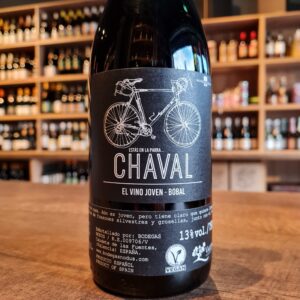 Young red wine with very fruity notes from the bobal. 100% organic wine with Vegan certification. Monitoring of maturation to determine the optimal time of harvest. Selection of grapes, controlled fermentation at low temperature and long maceration in stainless steel tanks. It came with very fruity notes from the bobal. Try it with pizza; couscous, rocket, roasted squash and spicy yogurt; or roast lamb.
Young red wine with very fruity notes from the bobal. 100% organic wine with Vegan certification. Monitoring of maturation to determine the optimal time of harvest. Selection of grapes, controlled fermentation at low temperature and long maceration in stainless steel tanks. It came with very fruity notes from the bobal. Try it with pizza; couscous, rocket, roasted squash and spicy yogurt; or roast lamb. -
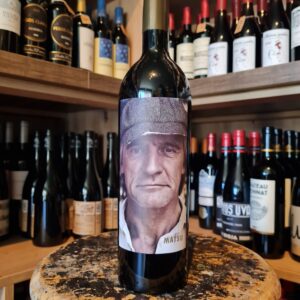 “El Recio translates as 'tough guy' and it's a clue to the style of this Tempranillo from Spain's Toro region. Made from old vines, cultivated biodynamically, the wine matures in new French oak for 14 months, giving it polish and opulence. Firm, sweet black fruit, almost fruit cake in character, with earthy and coffee notes. The guy in the picture must be a meat-eater – this wine is crying out for a juicy steak
“El Recio translates as 'tough guy' and it's a clue to the style of this Tempranillo from Spain's Toro region. Made from old vines, cultivated biodynamically, the wine matures in new French oak for 14 months, giving it polish and opulence. Firm, sweet black fruit, almost fruit cake in character, with earthy and coffee notes. The guy in the picture must be a meat-eater – this wine is crying out for a juicy steak -
 Hello my enthusiastic brethren or should I say Oenophilians! (I've just butchered the word a lit bit but I am sure you can relate to it). Wine Oenophilia is a love of wine. In the strictest sense, oenophilia describes a disciplined devotion to wine, accompanying strict traditions of consumption and appreciation. Wine lovers are also known as wine aficionados and connoisseurs. Its the people who appreciate and collect wine, particularly grape wines from certain regions, varieties or production methods. Maybe someone like you... So in the spirit of Oenophilia, I have put together 6 wines for those wine aficionados that want to push the bar a little further and feel excited. Here you have 2 whites, 1 bubbly and 3 reds, all of them are totally different from each other, underrated, unique and perform superbly in their own categories. Whites: Celler del Roure Cullerot 2019- This "orange" wine from Valencia is produced by Pablo Calatayud from Celler del Roure and let's say he brought the entire winemaking process back to basics. This is a blend of six different grapes, of which three of them were revived from ancient vines that were no longer in use. The setting is in an ancient country estate outside of Moixent, in the Valencia region. For centuries this was a farm producing grain, almonds, olives and grapes for the production of olive oil and wine. This farm contained a large, stone, olive press and extensive subterranean cellar with dozens of intact 17th century amphorae. It took a few years of research and restoration but Pablo is using these clay vessels to make wine once again. Cullerot, which means tadpole, is the white that Pablo makes in the old cellar utilizing Verdil, Pedro Ximénez, Macabeo and Chardonnay from vines ranging in age from 15–70 years old. Whole cluster pressing, natural yeast fermentation and aging in amphorae seems familiar, but it is in fact, timeless. Moment of Silence by Blankbottle - Blankbottle is not bound to a specific wine area or wine style. It’s from many different vineyards, scattered across the Western Cape of South Africa, different regions, micro-climates, soil types, and ultimately leads to different wine styles. It is driven by quality, adventure, excitement and mystery. And at the centre of it all, are the guys in the vineyards, viticulturists, winemakers, family, friends and Blankbottle fans. Stunning, all rounder there is nothing you can fault in this wine. Aromas of candied lemon, cooked apple and mango with a core of minerality. Soft and voluptuous, it has a lovely ripeness and a fleshy, creamy mouthfeel, which leads to a perfect tangy freshness giving some zip to its otherwise mellow feel. Filipa Pato 3B Sparkling Rosé- The Filipa Pato 3B Sparkling Rosé is a delicious treat of a wine from one of my favorite winemakers in Portugal. Filipa Pato is the daughter of arguably one of Portugal's most famous winemakers, Luis Pato. She is also married to a very famous Belgian Sommelier William Wouters. Despite of all of these influences, she is a fantastic winemaker in her own right since 2001. Filipa became famous when she deviated from the local traditional methods and started producing unique wines out of local indigenous grapes (Baga & Bical) that are biodynamic with minimum intervention and true to themselves and their terroir . Filipa's mantra is 'vinhos autênticos sem maquilagem' – Authentic Wines Without Makeup. The color of the 3B Rosé is a beautiful light pink. It’s soft on the nose, with light yeast, mineral, rose and strawberry aromatics. The palate is quite dry, with firm mineral flavors complemented by lemon and light raspberry. The mouthfeel is fantastically bubbly. It’s a very tasty, mineral-centric sparkler. Niepoort Voyeur 1 Ltr- Never a winemaker to shy away from experimentation, Dirk Niepoort has spent the last few years trialling amphora vinification. This is the upshot of those experiments: the first release of a field blend of old-vine red and white grapes, which spent eight months fermenting and ageing in six 1000L clay amphorae. One of the aims of the project was to reset expectations of Douro reds - all power, body and muscle. Instead, Voyeur is all about freshness, lightness and elegance, clocking in at only 12.5% alcohol. There is plenty of complexity here, partly from the sheer number of varieties in the blend; partly from earthy amphora notes. But what’s most striking is the pure red fruit and delicate florality of the wine. Chill slightly before serving and savour the freshness. Susumaniello IGP Puglia - The winery "i Pàstini", located in the heart of the Valle d'Itria land, strives to maintain the wisdom of traditions even with modern winemaking techniques, thus managing to obtain the best of enology Puglia has to offer. The vines are imported from nearby Dalmatia, which is one of the most important indigenous vines of the Brindisi area. Its name (there are several theories) is due to the fact that, a long time ago, the young Susumaniello plant was particularly productive, so much so, that it was overloaded with bunches as if it were a donkey. This unknown wine is underrated but will impress for its uniqueness and test your knowledge on how wine in general should taste like. This is a succulent and voluptuous wine with intense aromas of coffee liqueur, dark berry fruits and cocoa. Chat Fou Côtes du Rhône by Éric Texier - If you were ever sceptical about Organic wines, you have to give this one a try! This wine is Artisanal, Organic, Biodynamic, unfined and unfiltered. All with the aim to do as little intervention as possible and to let the Terroir speak for itself. Eric Texier Chat Fou natural red wine is a coupage of Grenache Tinta, Clairette and Marsanne, from the well known region of Côtes du Rhône.Eric Texier is a vigneron from Brézème, a municipality in the northern area of the Rhone Valley. For every occasion, red and white meats, charcuterie and to impress your other half.
Hello my enthusiastic brethren or should I say Oenophilians! (I've just butchered the word a lit bit but I am sure you can relate to it). Wine Oenophilia is a love of wine. In the strictest sense, oenophilia describes a disciplined devotion to wine, accompanying strict traditions of consumption and appreciation. Wine lovers are also known as wine aficionados and connoisseurs. Its the people who appreciate and collect wine, particularly grape wines from certain regions, varieties or production methods. Maybe someone like you... So in the spirit of Oenophilia, I have put together 6 wines for those wine aficionados that want to push the bar a little further and feel excited. Here you have 2 whites, 1 bubbly and 3 reds, all of them are totally different from each other, underrated, unique and perform superbly in their own categories. Whites: Celler del Roure Cullerot 2019- This "orange" wine from Valencia is produced by Pablo Calatayud from Celler del Roure and let's say he brought the entire winemaking process back to basics. This is a blend of six different grapes, of which three of them were revived from ancient vines that were no longer in use. The setting is in an ancient country estate outside of Moixent, in the Valencia region. For centuries this was a farm producing grain, almonds, olives and grapes for the production of olive oil and wine. This farm contained a large, stone, olive press and extensive subterranean cellar with dozens of intact 17th century amphorae. It took a few years of research and restoration but Pablo is using these clay vessels to make wine once again. Cullerot, which means tadpole, is the white that Pablo makes in the old cellar utilizing Verdil, Pedro Ximénez, Macabeo and Chardonnay from vines ranging in age from 15–70 years old. Whole cluster pressing, natural yeast fermentation and aging in amphorae seems familiar, but it is in fact, timeless. Moment of Silence by Blankbottle - Blankbottle is not bound to a specific wine area or wine style. It’s from many different vineyards, scattered across the Western Cape of South Africa, different regions, micro-climates, soil types, and ultimately leads to different wine styles. It is driven by quality, adventure, excitement and mystery. And at the centre of it all, are the guys in the vineyards, viticulturists, winemakers, family, friends and Blankbottle fans. Stunning, all rounder there is nothing you can fault in this wine. Aromas of candied lemon, cooked apple and mango with a core of minerality. Soft and voluptuous, it has a lovely ripeness and a fleshy, creamy mouthfeel, which leads to a perfect tangy freshness giving some zip to its otherwise mellow feel. Filipa Pato 3B Sparkling Rosé- The Filipa Pato 3B Sparkling Rosé is a delicious treat of a wine from one of my favorite winemakers in Portugal. Filipa Pato is the daughter of arguably one of Portugal's most famous winemakers, Luis Pato. She is also married to a very famous Belgian Sommelier William Wouters. Despite of all of these influences, she is a fantastic winemaker in her own right since 2001. Filipa became famous when she deviated from the local traditional methods and started producing unique wines out of local indigenous grapes (Baga & Bical) that are biodynamic with minimum intervention and true to themselves and their terroir . Filipa's mantra is 'vinhos autênticos sem maquilagem' – Authentic Wines Without Makeup. The color of the 3B Rosé is a beautiful light pink. It’s soft on the nose, with light yeast, mineral, rose and strawberry aromatics. The palate is quite dry, with firm mineral flavors complemented by lemon and light raspberry. The mouthfeel is fantastically bubbly. It’s a very tasty, mineral-centric sparkler. Niepoort Voyeur 1 Ltr- Never a winemaker to shy away from experimentation, Dirk Niepoort has spent the last few years trialling amphora vinification. This is the upshot of those experiments: the first release of a field blend of old-vine red and white grapes, which spent eight months fermenting and ageing in six 1000L clay amphorae. One of the aims of the project was to reset expectations of Douro reds - all power, body and muscle. Instead, Voyeur is all about freshness, lightness and elegance, clocking in at only 12.5% alcohol. There is plenty of complexity here, partly from the sheer number of varieties in the blend; partly from earthy amphora notes. But what’s most striking is the pure red fruit and delicate florality of the wine. Chill slightly before serving and savour the freshness. Susumaniello IGP Puglia - The winery "i Pàstini", located in the heart of the Valle d'Itria land, strives to maintain the wisdom of traditions even with modern winemaking techniques, thus managing to obtain the best of enology Puglia has to offer. The vines are imported from nearby Dalmatia, which is one of the most important indigenous vines of the Brindisi area. Its name (there are several theories) is due to the fact that, a long time ago, the young Susumaniello plant was particularly productive, so much so, that it was overloaded with bunches as if it were a donkey. This unknown wine is underrated but will impress for its uniqueness and test your knowledge on how wine in general should taste like. This is a succulent and voluptuous wine with intense aromas of coffee liqueur, dark berry fruits and cocoa. Chat Fou Côtes du Rhône by Éric Texier - If you were ever sceptical about Organic wines, you have to give this one a try! This wine is Artisanal, Organic, Biodynamic, unfined and unfiltered. All with the aim to do as little intervention as possible and to let the Terroir speak for itself. Eric Texier Chat Fou natural red wine is a coupage of Grenache Tinta, Clairette and Marsanne, from the well known region of Côtes du Rhône.Eric Texier is a vigneron from Brézème, a municipality in the northern area of the Rhone Valley. For every occasion, red and white meats, charcuterie and to impress your other half. -
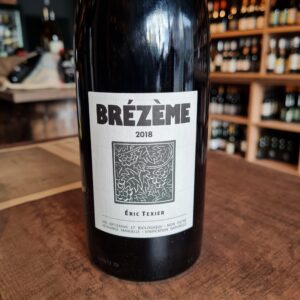 The 2019 Cotes du Rhone Brézème is a big, well structured wine that retains the freshness and lively character always present in this cuvee. The wine was vinified naturally, without added sulfur. The wine shows vivid aromas of blackberry and black cherry with hints of musk, blueberry, earth and citrus. The palate is deep and textured with earthy black fruits, bitter chocolate and mineral flavours, quite pure and long. Serve now, slightly chilled, with grilled meats, tagines and full-flavored cheeses, or cellar fo five to ten years or more.
The 2019 Cotes du Rhone Brézème is a big, well structured wine that retains the freshness and lively character always present in this cuvee. The wine was vinified naturally, without added sulfur. The wine shows vivid aromas of blackberry and black cherry with hints of musk, blueberry, earth and citrus. The palate is deep and textured with earthy black fruits, bitter chocolate and mineral flavours, quite pure and long. Serve now, slightly chilled, with grilled meats, tagines and full-flavored cheeses, or cellar fo five to ten years or more. -
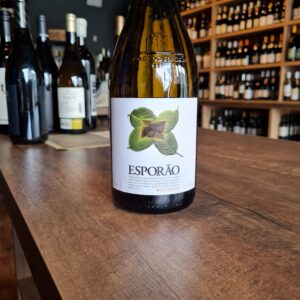 A classic wine(Organic) obtained from grapes grown at Herdade do Esporão, which showcases the consistency and rich character typical of the best Alentejo wines. It Is from vineyards that on average are about 18 years old, the soils are a mixture of granite and schist with clay and loam, and an integrated pest control and a sustainable viticultural approach is employed. Hand-harvested grapes are de-stemmed, then left with skin contact for six hours before chilling and fermentation, 50% in tank with fine lees ageing and 50% in barriques where it is aged for six months. French and American oak is used, a third new, and the wine does not undergo a malolactic fermentation. Aromas of ripe tangerine, honey and apricot with subtle notes of toast and smoke from the barrel fermentation. The palate is complex, creamy, showing ripe fruit flavours and mineral notes with a long, fresh finish.
A classic wine(Organic) obtained from grapes grown at Herdade do Esporão, which showcases the consistency and rich character typical of the best Alentejo wines. It Is from vineyards that on average are about 18 years old, the soils are a mixture of granite and schist with clay and loam, and an integrated pest control and a sustainable viticultural approach is employed. Hand-harvested grapes are de-stemmed, then left with skin contact for six hours before chilling and fermentation, 50% in tank with fine lees ageing and 50% in barriques where it is aged for six months. French and American oak is used, a third new, and the wine does not undergo a malolactic fermentation. Aromas of ripe tangerine, honey and apricot with subtle notes of toast and smoke from the barrel fermentation. The palate is complex, creamy, showing ripe fruit flavours and mineral notes with a long, fresh finish. -
 This is the first wine made by Esporão back in 1985. Label illustrated by António Poppe that changes with every organic vintage. Classic wine style made from estate grown grapes that shows the consistency and the rich, ripe fruit characters which are typical of the best Alentejo red wines. Deep dark red colour with intense spicy aroma of mature red berry fruits with discrete oak complexity. On the palate it is elegant, dense and creamy.
This is the first wine made by Esporão back in 1985. Label illustrated by António Poppe that changes with every organic vintage. Classic wine style made from estate grown grapes that shows the consistency and the rich, ripe fruit characters which are typical of the best Alentejo red wines. Deep dark red colour with intense spicy aroma of mature red berry fruits with discrete oak complexity. On the palate it is elegant, dense and creamy. -
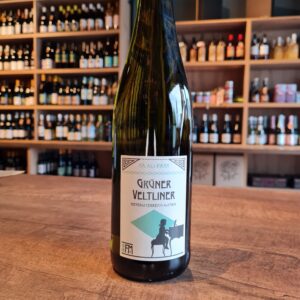 Gruner Veltliner is Austria’s most important indigenous grape and up until the 1990s it was relatively unheard of. Gruner Veltliner has many charms, one of them being the consistency of the quality and the flavour profile; it always delivers what it says on the tin. Ferdinand Mayr is a musician turned winemaker and his organic wines are singing with flavour and intensity. Whoever says Grüner Veltliner says Austria and vice versa. This version of Ferdinand Mayr is accessible and it charms you right away. Exuberant, lively nose of citrus, apple and white pepper. On the palate, the ripe fruit and spiciness create a pleasant tension with the acidity. Crispy and ripe, as if you were biting into a juicy apple. Flavor and spiciness characterize this wine. Fantastic with Japanese or Thai cuisine.
Gruner Veltliner is Austria’s most important indigenous grape and up until the 1990s it was relatively unheard of. Gruner Veltliner has many charms, one of them being the consistency of the quality and the flavour profile; it always delivers what it says on the tin. Ferdinand Mayr is a musician turned winemaker and his organic wines are singing with flavour and intensity. Whoever says Grüner Veltliner says Austria and vice versa. This version of Ferdinand Mayr is accessible and it charms you right away. Exuberant, lively nose of citrus, apple and white pepper. On the palate, the ripe fruit and spiciness create a pleasant tension with the acidity. Crispy and ripe, as if you were biting into a juicy apple. Flavor and spiciness characterize this wine. Fantastic with Japanese or Thai cuisine. -
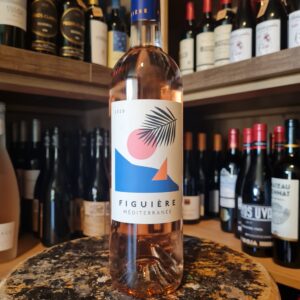 Here is a Provençal estate rosé sure to add some style to your summer! One smell, one sip and you get beamed to the Mediterranean Sea! This delicious Rosé is created by a pioneering Provence domaine of excellence. The family Combard is one of the ambassadors of a new generation of prestigious winemakers. You can smell notes of white flowers that then develop into white peach aromas. The palate expresses the velvety texture of citrus peel and the zestiness of an essential oil. Citrus profile with this wine that is astringent, green, tight and fresh.
Here is a Provençal estate rosé sure to add some style to your summer! One smell, one sip and you get beamed to the Mediterranean Sea! This delicious Rosé is created by a pioneering Provence domaine of excellence. The family Combard is one of the ambassadors of a new generation of prestigious winemakers. You can smell notes of white flowers that then develop into white peach aromas. The palate expresses the velvety texture of citrus peel and the zestiness of an essential oil. Citrus profile with this wine that is astringent, green, tight and fresh. -
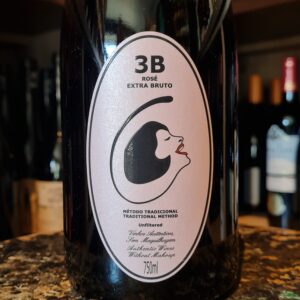 The Filipa Pato 3B Sparkling Rosé is a delicious treat of a wine from one of my favorite winemakers in Portugal. Filipa Pato is the daughter of arguably one of Portugal's most famous winemakers, Luis Pato. Passion for the traditional indigenous grape varietals of Bairrada led Filipa Pato to start her own project in 2001. She works a total of 12 hectares of vineyards scattered in various plots throughout the Bairrada appellation of Portugal. Utilizing biodynamic farming practices and minimal-intervention winemaking. The 3B is a homage to the traditional sparkling wines of Bairrada, with this being a blend of the indigenous Baga and Bical grapes. The Bical adds mineral and citrus notes to the berry red fruit notes of the Baga. This is a great little sparkler with a dry finish. Filipa and her husband, Belgian sommelier and restaurateur William Wouters, produce vinhos autênticos sem maquilagem – 'Authentic Wines Without Makeup.' 3B's-Bairrada, Baga & Bical
The Filipa Pato 3B Sparkling Rosé is a delicious treat of a wine from one of my favorite winemakers in Portugal. Filipa Pato is the daughter of arguably one of Portugal's most famous winemakers, Luis Pato. Passion for the traditional indigenous grape varietals of Bairrada led Filipa Pato to start her own project in 2001. She works a total of 12 hectares of vineyards scattered in various plots throughout the Bairrada appellation of Portugal. Utilizing biodynamic farming practices and minimal-intervention winemaking. The 3B is a homage to the traditional sparkling wines of Bairrada, with this being a blend of the indigenous Baga and Bical grapes. The Bical adds mineral and citrus notes to the berry red fruit notes of the Baga. This is a great little sparkler with a dry finish. Filipa and her husband, Belgian sommelier and restaurateur William Wouters, produce vinhos autênticos sem maquilagem – 'Authentic Wines Without Makeup.' 3B's-Bairrada, Baga & Bical


